
IELTS General Training
A hub for IELTS GT test takers to help them reach their goal.

Essay 22 – Is traditional music more important than International music
Gt writing task 2 (essay writing) sample # 22.
You should spend about 40 minutes on this task.
Present a written argument or case to an educated reader with no specialist knowledge of the following topic:
There are many different types of music in the world today. Why do we need music? Is the traditional music of a country more important than the international music that is heard everywhere nowadays?
You should write at least 250 words.
Use your own ideas, knowledge and experience and support your arguments with examples and relevant evidence.
Model Answer 1: [View: Neutral Opinion]
Music is an intrinsic part of human culture and plays a significant role in our lives. This essay aims to explore the importance of music and examine whether traditional music holds more significance than international music in today’s globalized world.
One of the primary reasons why we need music is its ability to evoke emotions and enhance our well-being. Music has a profound impact on our mood, relieving stress, and providing comfort and solace. It serves as a universal language that transcends barriers and allows individuals to connect with their inner selves and with others. Moreover, music serves as a means of cultural expression and promoting cultural identity.
The traditional music of a country carries the legacy of its people, their history, values, and customs. It serves as a cultural archive, reflecting the unique heritage of a nation and providing a sense of belonging to its citizens.
However, in today’s interconnected world, international music has become increasingly prevalent. It offers a platform for cross-cultural exchange and allows individuals to appreciate diverse musical styles and genres. International music fosters cultural understanding and promotes unity among people from different backgrounds. While traditional music holds cultural significance, it is important to recognize the value of international music in enriching our musical experiences. Global music collaborations and fusion of different styles can lead to the creation of innovative and captivating melodies that resonate with a wider audience.
In conclusion, music serves as a universal language that evokes emotions, promotes well-being, and fosters cultural expression. While traditional music is vital in preserving cultural heritage, international music has its own merits in promoting cross-cultural understanding and appreciation. Rather than viewing traditional and international music as mutually exclusive, it is essential to embrace both and celebrate the richness and diversity of musical expressions.
Model Answer 2: [Neutral opinion]
We love listening to music whether we are at home, at work or on the streets. In fact, music has become a part of our daily life whether it is traditional music or international music. Therefore it is fair to suggest that we need music because it is good for our souls, and it helps calm us down during the time of stress and anxiety besides conveying our human feeling from generation to generation. Because both “traditional music” and “international music” types enjoy a certain degree of popularity among music lovers, I am not hesitant to say that both of them are equally important for a country.
Traditional music, of course, can help understand the important elements of culture, heritage, history and the emotions of a particular country. But that does not necessarily mean that those particular “elements” always remain the same. They also go through some internal changes as time progresses, and simply because we, humans, are just not programmed to remain the same always. These changes are certainly reflected in “traditional music” as well, be it through a different kind of rhythm or a different kind of musical instrument. And, if these “changes” indeed are incorporated into the “traditional music”, they do not always remain “traditional”! Besides, who is to decide what is “traditional music” and which is ‘international music”, when many “not-so” traditional elements of international music are getting integrated into traditional music easily and rather “successfully” sometimes. For example, the “traditional tabla” (made of woods) in Bangladeshi folk songs is frequently being replaced by “metal made drums”, but it doesn’t exactly reduce the appeal and traditional value of that particular type of folklore songs in any manner.
Then, of course, there are satellite TV channels and the internet which have virtually erased the already “not-so” visible boundary line between traditional music and international music whereby we are continuously being “subject” to the music of other countries. Sometimes, we actually even like music from other countries. But in that case, it does not mean that our traditional music is becoming any less important to us.
To conclude, traditional music and international music are equally important for a country if it wants to preserve and also carry forward its traditions and cultures.
Model Answer 3: [View: traditional music is more important than the international music ]
Music is an essential cultural and traditional component of a nation and a rich variety of music could be found all around the world that not only entertains us but also expresses our joy, nationalism, freedom, happiness, love and struggles in the finest form of arts. Despite the huge popularity of international music, traditional music is still more important due to its adherence to the traditional aspects of a country.
We need music because it makes our life meaningful and accompanies us throughout our lives. In our childhood, we listen to and learn music simply as a form of entertainment and joy. We learn to sing our national anthem and our parents sing to us to help us sleep. Later in life, we come across a variety of songs and music as part of our life stories and our favourite music often defines the person we become. In our old age, we see life and recite memories through music we love. Music both expresses and arouses emotions in a way that words alone cannot, and it tells stories of our lives that we long to hear. Thus we need music to relax, be entertained, be inspired, express our feelings and often relieve boredom in life.
In considering which kind of music is the most important, we must acknowledge that traditional music teaches people about their history and helps people remember and retain their national and cultural identity. International music is often set in a totally different environment that we have no experience in and despite engaging and entertaining lyrics and music style, it is often a commercial product which fails to reflect the true stories in our life. Traditional music, by contrast, expresses the culture, tradition and history of a country and gives narratives of people and their life in a way that will be always relevant. Thus traditional music, without any doubt, is more important for us as people in a society and a country.
In conclusion, music is a crucial part of our life and existence, and I believe that traditional music should be given more importance than international music so that we can enjoy music not only for entertainment’s sake but also to learn who we really are.
Model Answer 4: [View: International music is more important than traditional music ]
In this day and age, different kinds of music genres prevail around the globe and one can find a stunning range of categories and styles according to his choice. No doubt, music is of critical importance to us for several reasons and despite conventional music nurturing nationalism, I unswervingly believe that global music is highly significant by reason of diversity.
No matter when, where and how music was invented, it has been playing a vital role in our society for a really long. Music can touch our feelings and even change them by soothing the nerves and many researchers suggest that music can invoke catharsis feelings in the listeners who have emotional stress and tension. In addition to this, music can reach the core of our minds and inspire us greatly. That is why, in nursing homes, they commence with musical therapy so as to let the old people remember the incidents of their sweet past.
International music is of considerable importance despite the fact that folk music resonates with the culture, heritage and legacy of a nation. There are myriad reasons in favour of international music. The most prominent one is solidarity. In simple words, world music brings together a diverse range of cultures and histories and thereby demonstrates different paradigms of notions, worldviews and so forth; which in turn transcend cultural differences and tear down the barriers of social class, ethnicity, national identity and so on. A case in point is the song “Wind of Change” by Scorpions, which is a rallying cry for unification and for freedom and a message of hope.
On a final note, traditional music is a strong carrier of the culture, history, and heritage of a nation. Nevertheless, global music paves the way for international unity which is crucial as the world we live in has become a global village.
One Comment to “Essay 22 – Is traditional music more important than International music”
The importance and popularity of various genres of music, all around the world, are undeniable, and music is called the food for our soul. Nevertheless, with the popularity of various international music, it is necessary to underline the importance of traditional music in an era of globalization, as traditional music allows small nations to keep their tradition alive.
We need music because music speaks out the heart and aids cognitive development. It also allows people to pass through the hard moments in life by inspiring them. Music not only calms our nervous system but teaches us how to continue to persuade our aims, regardless of the external circumstances. That is why music is extremely important and popular among people. When humans fall in love or struggle to find themselves in the big world, music accompany them. In an era of competition and mechanisation and immediate gratification, music plays the role of the counter-balance, which balances our life by affiliating our emotional tensions.
It is at the same time crucial to underline the significance of traditional music in an era of globalization and cutting-edge portable devices which promote international music and decrease the diversity of cultures. Traditional music nowadays is not popular, especially among the young generation but plays a crucial role in keeping our important traditions, national customs alive. Therefore traditional music is often played in various national holidays and events. Traditional music is able to gather people who belong to the same cultural and religious affiliations together and enrich the bonds among the same nations who live today in a different part of the world. For example, a range of Indian communities, which nowadays exist all around the globe, still listen to their own traditional music, and it allows them to maintain and successfully translate various national traditions to the next generation who was born and grew up abroad, away from their homeland.
In conclusion, music is a necessary element of our life that supports and cures our emotional states. The significance of traditional music might be seen in its ability to save and translate cultural traditions among generations.
Leave a Reply Cancel reply
Your email address will not be published. Required fields are marked *
Privacy Overview
Academia.edu no longer supports Internet Explorer.
To browse Academia.edu and the wider internet faster and more securely, please take a few seconds to upgrade your browser .
Enter the email address you signed up with and we'll email you a reset link.
- We're Hiring!
- Help Center

A Brief Introduction to Traditional Music in Nigeria: A Case Study of the Three Major Ethnic Groups.

2021, Academia Letters
This paper is a brief introduction to traditional music in Nigeria, particularly, amongst Nigeria's three major ethnic groups (Hausa, Igbo, and Yoruba). It covers a very short span in the evolution of these musical genres. Nonetheless, the paper offers some useful insight into the functional, ceremonial roles of music in a typical traditional society in Nigeria.
Related Papers
Journal of the Association of Nigerian Musicologists.
Olupemi Oludare
The Yoruba people are blessed with a rich musical culture, with their traditional music engaging various arts and exhibiting their musical and extra-musical identities. Domiciled in Southwestern part of Nigeria, the Yoruba often express their socio-cultural way of life through music. This is epitomized in Yoruba traditional music in which the musical structure reflects the social structure. The music's vocal, instrumental, rhythmic and dance practices portray the religious, leadership, kinship and gender ethics and hierarchy of Yoruba traditional institutions. This study therefore discusses different perspectives on music as art in examining how the Yoruba social structure is reflected in their traditional music. It employs descriptive analysis for its methodology, with primary data elicited through oral interviews and observations and secondary data through bibliography. The study revealed that Yoruba traditional music does not only serve musical purposes, but also showcases and conserves the extra-musical arts of panegyrics, chants, poetries, dance, masks, costumes, rituals, instrumentations and entertainment. This study concludes that the Yoruba traditional music function as an artistic expression of their socio attributes and recommends further research into Nigerian musical and socio-cultural arts.
Developing Country Studies
sekinat A lasisi
Oghenemudiakevwe Igbi
Music is one of the oldest and most practiced arts in Nigerian traditional societies. The revered place of music in the lives of Nigerians is indisputable, as a consequence of its towering roles in nearly all communal events and activities. In Nigeria, music is utilized in diverse facets especially in religious, economic, martial, and political life of the people. In other words, it is unusual to preclude music from any societal event. Though these attributes pervade all Nigerian traditional societies, it is even more fascinating that every ethnic group or culture has their peculiar music with which they are recognized. Thus, there is bound to be dissimilarities in the manner in which various societies regard music as a concept, phenomenon, or how it functions in traditional life. The thrust of this paper therefore, is to examine music as a phenomenon, its roles in society, and how it is conceived by the people of Plateau. Data were gathered using ethnographic method, while interviews formed a significant part of the research tools. Some existing videos and those collected from the field were analysed by the authors. Findings from data gleaned reveal that there is a plethora of music types among the Plateau people. It is also gathered that music forms a fundamental aspect of life on the Plateau, and is widely used in virtually all communal events. However, research efforts into the different traditional music types of the people of Plateau need to be intensified and sustained over time, in order to document findings that will further lead to addressing the protracted challenge of dearth of literature in the traditional music of the area under study.
Olaleye Olufemi Akanji
henry egede
IGWEBUIKE: An African Journal of Arts and Humanities (IAAJAH)
ADEBAYO OLUDARE OGUNYEMI
Traditional music is central to the lives of the Yorùbá people. This genre of music is constantly being challenged by emerging trends in musical arts in the Yorùbá states of the South Western Nigeria. It has continued to writhe under the stress of urbanization and globalization. The challenge of upholding this waning musical tradition falls on the surviving socio-political institutions. This paper therefore, examines the Gb du traditional music of the of p people of Lagos State. The article examines the sound, the structural patterns and other extraneous content of this particular traditional drums as performed in p land. Exploring ethnomusicological approach, the study relies on archival and ethnographic sources for its methodology. The article employs as research instruments, focus group discussion, key informant interview, non-participants' observation methods to elicit data. This article aims at bringing into focus critical perspectives of traditional music of the Yorùbá people. Primary data for the article were collected from the palace of Olú of p , a prominent and ancient Yorùbá town in Lagos state, South West Nigeria. This article concludes that efforts need to be made by concerned authorities to promote Yoruba traditional music and preserve it from going into extinction.
Ayokunmi OlaOluwa
It is improper to conclude that music of a particular tongue or tribe has no form. More so, music in general has its functions in every human society, either they realize it or not. Yoruba Folk music as a case study of this paper, is a type of music that emerged from various cultural practices of people who by virtue of geographical location or language are bound together. Looking at Yoruba folk songs through the perspective of children game, it is realized that call and responses, repetitions are paramount. Hence, this paper addresses the form and the noble functions of its cultural transmission, moral teachings and entertainment in Nigeria today; especially through children game songs in Yoruba land.
Charles Aluede
Nigeria is made up of autochthonous groups with diverse musical cultures. In this essay, the researcher observes that over generalization associated with the characteristics of African music in general and Nigerian music in particular can no longer hold sway because each ethnic group has its peculiar musical attributes. In this connection, he gives an in depth examination of Esan music, of Nigeria by highlighting what he sees to be unique in the musical performances of this people.
Journal of the Association of Nigerian Musicologists
Oluwatosin J Ibitoye
The diachronic realities of indigenous African culture (especially that of music) in the consciousness of rising modern popular culture calls for urgent attention. Hence, it is imperative for scholars and researchers to pay attention to the dwindling knowledge of culture. Against this backdrop, this study documents the indigenous music arts among Ilorin people of Kwara State in North Central, Nigeria. This ethnographic research relies on descriptive method, field observations of indigenous musicians in Ilorin and book reviews. This study reveals the influence of the Islamic religion on the indigenous musical arts in Ilorin vis-à-vis urbanization and modern culture as acceptance and popularity of the indigenous practices is reliant on the permeation of religion. Findings reveal the multifaceted functionalities of these indigenous styles and the issue of gender relativity in their musicianship. This study posits that, the syncretic effects of western culture, civilization, religion, the issue of culture change against the culture of restraint contributed to the evolution and emergence of new indigenous styles, thereby, sending old styles into oblivion. This study therefore recommends the need for more efficiency of designated centres and repositories of culture discussed in this study, in the bid to preserve music of the Ilorin people.
Musicological Brainfood
Jude Orakwe
Adverting to the method of narration and the approach of narrativity, the author, in this brief exposition, chronicles his experience in the field of theoretical and practical study of music, starting with his academic journey in Europe and ending up with ethnomusicological studies in America. Further, there's a discourse on the nuanced application he's presently making of the knowledge he gained in his career as a university music lecturer and director of music. The nuance has to do with the system and approach to Africans' study of music in Nigeria, which on the one hand is not too dissimilar to what Nigerians who studied music outside Nigeria experienced in European and American universities but which, on the other hand, cannot be exactly same due to the unique sitz-im-leben of students and departments of music in Nigeria.
RELATED PAPERS
Neuropsychopharmacology
Charles Nemeroff
Kathleen Broer
CALL/WA 0857 4713 3213|model baju lebaran tahun 2021 couple
dheashoop baju
Borneo Journal of Resource Science and Technology
Ruhana Hassan
The Journal of organic chemistry
Henry Weinberg
Hypertension
Markku Saraheimo
Frontiers in Public Health
susana olivera
Brian Barkdoll
Géolinguistique
Matteo Rivoira
Christian Kimmich
Dalton Trans.
Teresa Nunes
Espacio Abierto Cuaderno Venezolano De Sociologia
Roberto Briceño-León
Journal of Northwest Atlantic Fishery Science
REVISTA AGRO@MBIENTE ON-LINE
Marcio Busi Da Silva
European Journal of Science and Technology
Mustafa Timur
História Oral
Gabriel Amato
Revista Argentina De Cardiologia
Ana Maria Balaszczuk
Journal of the American Animal Hospital Association
Cristina Gobello
hariansi panimba
Journal of Management Scholarship
MUHAMMAD SALAEBING
Molecular Pharmacology
Thue Schwartz
Journal of Surgical Sciences
hyutrTT hytutr
- We're Hiring!
- Help Center
- Find new research papers in:
- Health Sciences
- Earth Sciences
- Cognitive Science
- Mathematics
- Computer Science
- Academia ©2024
- Search Menu
- Browse content in Arts and Humanities
- Browse content in Archaeology
- Anglo-Saxon and Medieval Archaeology
- Archaeological Methodology and Techniques
- Archaeology by Region
- Archaeology of Religion
- Archaeology of Trade and Exchange
- Biblical Archaeology
- Contemporary and Public Archaeology
- Environmental Archaeology
- Historical Archaeology
- History and Theory of Archaeology
- Industrial Archaeology
- Landscape Archaeology
- Mortuary Archaeology
- Prehistoric Archaeology
- Underwater Archaeology
- Urban Archaeology
- Zooarchaeology
- Browse content in Architecture
- Architectural Structure and Design
- History of Architecture
- Residential and Domestic Buildings
- Theory of Architecture
- Browse content in Art
- Art Subjects and Themes
- History of Art
- Industrial and Commercial Art
- Theory of Art
- Biographical Studies
- Byzantine Studies
- Browse content in Classical Studies
- Classical History
- Classical Philosophy
- Classical Mythology
- Classical Literature
- Classical Reception
- Classical Art and Architecture
- Classical Oratory and Rhetoric
- Greek and Roman Epigraphy
- Greek and Roman Law
- Greek and Roman Papyrology
- Greek and Roman Archaeology
- Late Antiquity
- Religion in the Ancient World
- Digital Humanities
- Browse content in History
- Colonialism and Imperialism
- Diplomatic History
- Environmental History
- Genealogy, Heraldry, Names, and Honours
- Genocide and Ethnic Cleansing
- Historical Geography
- History by Period
- History of Emotions
- History of Agriculture
- History of Education
- History of Gender and Sexuality
- Industrial History
- Intellectual History
- International History
- Labour History
- Legal and Constitutional History
- Local and Family History
- Maritime History
- Military History
- National Liberation and Post-Colonialism
- Oral History
- Political History
- Public History
- Regional and National History
- Revolutions and Rebellions
- Slavery and Abolition of Slavery
- Social and Cultural History
- Theory, Methods, and Historiography
- Urban History
- World History
- Browse content in Language Teaching and Learning
- Language Learning (Specific Skills)
- Language Teaching Theory and Methods
- Browse content in Linguistics
- Applied Linguistics
- Cognitive Linguistics
- Computational Linguistics
- Forensic Linguistics
- Grammar, Syntax and Morphology
- Historical and Diachronic Linguistics
- History of English
- Language Acquisition
- Language Evolution
- Language Reference
- Language Variation
- Language Families
- Lexicography
- Linguistic Anthropology
- Linguistic Theories
- Linguistic Typology
- Phonetics and Phonology
- Psycholinguistics
- Sociolinguistics
- Translation and Interpretation
- Writing Systems
- Browse content in Literature
- Bibliography
- Children's Literature Studies
- Literary Studies (Asian)
- Literary Studies (European)
- Literary Studies (Eco-criticism)
- Literary Studies (Romanticism)
- Literary Studies (American)
- Literary Studies (Modernism)
- Literary Studies - World
- Literary Studies (1500 to 1800)
- Literary Studies (19th Century)
- Literary Studies (20th Century onwards)
- Literary Studies (African American Literature)
- Literary Studies (British and Irish)
- Literary Studies (Early and Medieval)
- Literary Studies (Fiction, Novelists, and Prose Writers)
- Literary Studies (Gender Studies)
- Literary Studies (Graphic Novels)
- Literary Studies (History of the Book)
- Literary Studies (Plays and Playwrights)
- Literary Studies (Poetry and Poets)
- Literary Studies (Postcolonial Literature)
- Literary Studies (Queer Studies)
- Literary Studies (Science Fiction)
- Literary Studies (Travel Literature)
- Literary Studies (War Literature)
- Literary Studies (Women's Writing)
- Literary Theory and Cultural Studies
- Mythology and Folklore
- Shakespeare Studies and Criticism
- Browse content in Media Studies
- Browse content in Music
- Applied Music
- Dance and Music
- Ethics in Music
- Ethnomusicology
- Gender and Sexuality in Music
- Medicine and Music
- Music Cultures
- Music and Religion
- Music and Media
- Music and Culture
- Music Education and Pedagogy
- Music Theory and Analysis
- Musical Scores, Lyrics, and Libretti
- Musical Structures, Styles, and Techniques
- Musicology and Music History
- Performance Practice and Studies
- Race and Ethnicity in Music
- Sound Studies
- Browse content in Performing Arts
- Browse content in Philosophy
- Aesthetics and Philosophy of Art
- Epistemology
- Feminist Philosophy
- History of Western Philosophy
- Metaphysics
- Moral Philosophy
- Non-Western Philosophy
- Philosophy of Science
- Philosophy of Language
- Philosophy of Mind
- Philosophy of Perception
- Philosophy of Action
- Philosophy of Law
- Philosophy of Religion
- Philosophy of Mathematics and Logic
- Practical Ethics
- Social and Political Philosophy
- Browse content in Religion
- Biblical Studies
- Christianity
- East Asian Religions
- History of Religion
- Judaism and Jewish Studies
- Qumran Studies
- Religion and Education
- Religion and Health
- Religion and Politics
- Religion and Science
- Religion and Law
- Religion and Art, Literature, and Music
- Religious Studies
- Browse content in Society and Culture
- Cookery, Food, and Drink
- Cultural Studies
- Customs and Traditions
- Ethical Issues and Debates
- Hobbies, Games, Arts and Crafts
- Lifestyle, Home, and Garden
- Natural world, Country Life, and Pets
- Popular Beliefs and Controversial Knowledge
- Sports and Outdoor Recreation
- Technology and Society
- Travel and Holiday
- Visual Culture
- Browse content in Law
- Arbitration
- Browse content in Company and Commercial Law
- Commercial Law
- Company Law
- Browse content in Comparative Law
- Systems of Law
- Competition Law
- Browse content in Constitutional and Administrative Law
- Government Powers
- Judicial Review
- Local Government Law
- Military and Defence Law
- Parliamentary and Legislative Practice
- Construction Law
- Contract Law
- Browse content in Criminal Law
- Criminal Procedure
- Criminal Evidence Law
- Sentencing and Punishment
- Employment and Labour Law
- Environment and Energy Law
- Browse content in Financial Law
- Banking Law
- Insolvency Law
- History of Law
- Human Rights and Immigration
- Intellectual Property Law
- Browse content in International Law
- Private International Law and Conflict of Laws
- Public International Law
- IT and Communications Law
- Jurisprudence and Philosophy of Law
- Law and Politics
- Law and Society
- Browse content in Legal System and Practice
- Courts and Procedure
- Legal Skills and Practice
- Primary Sources of Law
- Regulation of Legal Profession
- Medical and Healthcare Law
- Browse content in Policing
- Criminal Investigation and Detection
- Police and Security Services
- Police Procedure and Law
- Police Regional Planning
- Browse content in Property Law
- Personal Property Law
- Study and Revision
- Terrorism and National Security Law
- Browse content in Trusts Law
- Wills and Probate or Succession
- Browse content in Medicine and Health
- Browse content in Allied Health Professions
- Arts Therapies
- Clinical Science
- Dietetics and Nutrition
- Occupational Therapy
- Operating Department Practice
- Physiotherapy
- Radiography
- Speech and Language Therapy
- Browse content in Anaesthetics
- General Anaesthesia
- Neuroanaesthesia
- Browse content in Clinical Medicine
- Acute Medicine
- Cardiovascular Medicine
- Clinical Genetics
- Clinical Pharmacology and Therapeutics
- Dermatology
- Endocrinology and Diabetes
- Gastroenterology
- Genito-urinary Medicine
- Geriatric Medicine
- Infectious Diseases
- Medical Toxicology
- Medical Oncology
- Pain Medicine
- Palliative Medicine
- Rehabilitation Medicine
- Respiratory Medicine and Pulmonology
- Rheumatology
- Sleep Medicine
- Sports and Exercise Medicine
- Clinical Neuroscience
- Community Medical Services
- Critical Care
- Emergency Medicine
- Forensic Medicine
- Haematology
- History of Medicine
- Browse content in Medical Dentistry
- Oral and Maxillofacial Surgery
- Paediatric Dentistry
- Restorative Dentistry and Orthodontics
- Surgical Dentistry
- Browse content in Medical Skills
- Clinical Skills
- Communication Skills
- Nursing Skills
- Surgical Skills
- Medical Ethics
- Medical Statistics and Methodology
- Browse content in Neurology
- Clinical Neurophysiology
- Neuropathology
- Nursing Studies
- Browse content in Obstetrics and Gynaecology
- Gynaecology
- Occupational Medicine
- Ophthalmology
- Otolaryngology (ENT)
- Browse content in Paediatrics
- Neonatology
- Browse content in Pathology
- Chemical Pathology
- Clinical Cytogenetics and Molecular Genetics
- Histopathology
- Medical Microbiology and Virology
- Patient Education and Information
- Browse content in Pharmacology
- Psychopharmacology
- Browse content in Popular Health
- Caring for Others
- Complementary and Alternative Medicine
- Self-help and Personal Development
- Browse content in Preclinical Medicine
- Cell Biology
- Molecular Biology and Genetics
- Reproduction, Growth and Development
- Primary Care
- Professional Development in Medicine
- Browse content in Psychiatry
- Addiction Medicine
- Child and Adolescent Psychiatry
- Forensic Psychiatry
- Learning Disabilities
- Old Age Psychiatry
- Psychotherapy
- Browse content in Public Health and Epidemiology
- Epidemiology
- Public Health
- Browse content in Radiology
- Clinical Radiology
- Interventional Radiology
- Nuclear Medicine
- Radiation Oncology
- Reproductive Medicine
- Browse content in Surgery
- Cardiothoracic Surgery
- Gastro-intestinal and Colorectal Surgery
- General Surgery
- Neurosurgery
- Paediatric Surgery
- Peri-operative Care
- Plastic and Reconstructive Surgery
- Surgical Oncology
- Transplant Surgery
- Trauma and Orthopaedic Surgery
- Vascular Surgery
- Browse content in Science and Mathematics
- Browse content in Biological Sciences
- Aquatic Biology
- Biochemistry
- Bioinformatics and Computational Biology
- Developmental Biology
- Ecology and Conservation
- Evolutionary Biology
- Genetics and Genomics
- Microbiology
- Molecular and Cell Biology
- Natural History
- Plant Sciences and Forestry
- Research Methods in Life Sciences
- Structural Biology
- Systems Biology
- Zoology and Animal Sciences
- Browse content in Chemistry
- Analytical Chemistry
- Computational Chemistry
- Crystallography
- Environmental Chemistry
- Industrial Chemistry
- Inorganic Chemistry
- Materials Chemistry
- Medicinal Chemistry
- Mineralogy and Gems
- Organic Chemistry
- Physical Chemistry
- Polymer Chemistry
- Study and Communication Skills in Chemistry
- Theoretical Chemistry
- Browse content in Computer Science
- Artificial Intelligence
- Computer Architecture and Logic Design
- Game Studies
- Human-Computer Interaction
- Mathematical Theory of Computation
- Programming Languages
- Software Engineering
- Systems Analysis and Design
- Virtual Reality
- Browse content in Computing
- Business Applications
- Computer Security
- Computer Games
- Computer Networking and Communications
- Digital Lifestyle
- Graphical and Digital Media Applications
- Operating Systems
- Browse content in Earth Sciences and Geography
- Atmospheric Sciences
- Environmental Geography
- Geology and the Lithosphere
- Maps and Map-making
- Meteorology and Climatology
- Oceanography and Hydrology
- Palaeontology
- Physical Geography and Topography
- Regional Geography
- Soil Science
- Urban Geography
- Browse content in Engineering and Technology
- Agriculture and Farming
- Biological Engineering
- Civil Engineering, Surveying, and Building
- Electronics and Communications Engineering
- Energy Technology
- Engineering (General)
- Environmental Science, Engineering, and Technology
- History of Engineering and Technology
- Mechanical Engineering and Materials
- Technology of Industrial Chemistry
- Transport Technology and Trades
- Browse content in Environmental Science
- Applied Ecology (Environmental Science)
- Conservation of the Environment (Environmental Science)
- Environmental Sustainability
- Environmentalist Thought and Ideology (Environmental Science)
- Management of Land and Natural Resources (Environmental Science)
- Natural Disasters (Environmental Science)
- Nuclear Issues (Environmental Science)
- Pollution and Threats to the Environment (Environmental Science)
- Social Impact of Environmental Issues (Environmental Science)
- History of Science and Technology
- Browse content in Materials Science
- Ceramics and Glasses
- Composite Materials
- Metals, Alloying, and Corrosion
- Nanotechnology
- Browse content in Mathematics
- Applied Mathematics
- Biomathematics and Statistics
- History of Mathematics
- Mathematical Education
- Mathematical Finance
- Mathematical Analysis
- Numerical and Computational Mathematics
- Probability and Statistics
- Pure Mathematics
- Browse content in Neuroscience
- Cognition and Behavioural Neuroscience
- Development of the Nervous System
- Disorders of the Nervous System
- History of Neuroscience
- Invertebrate Neurobiology
- Molecular and Cellular Systems
- Neuroendocrinology and Autonomic Nervous System
- Neuroscientific Techniques
- Sensory and Motor Systems
- Browse content in Physics
- Astronomy and Astrophysics
- Atomic, Molecular, and Optical Physics
- Biological and Medical Physics
- Classical Mechanics
- Computational Physics
- Condensed Matter Physics
- Electromagnetism, Optics, and Acoustics
- History of Physics
- Mathematical and Statistical Physics
- Measurement Science
- Nuclear Physics
- Particles and Fields
- Plasma Physics
- Quantum Physics
- Relativity and Gravitation
- Semiconductor and Mesoscopic Physics
- Browse content in Psychology
- Affective Sciences
- Clinical Psychology
- Cognitive Psychology
- Cognitive Neuroscience
- Criminal and Forensic Psychology
- Developmental Psychology
- Educational Psychology
- Evolutionary Psychology
- Health Psychology
- History and Systems in Psychology
- Music Psychology
- Neuropsychology
- Organizational Psychology
- Psychological Assessment and Testing
- Psychology of Human-Technology Interaction
- Psychology Professional Development and Training
- Research Methods in Psychology
- Social Psychology
- Browse content in Social Sciences
- Browse content in Anthropology
- Anthropology of Religion
- Human Evolution
- Medical Anthropology
- Physical Anthropology
- Regional Anthropology
- Social and Cultural Anthropology
- Theory and Practice of Anthropology
- Browse content in Business and Management
- Business Strategy
- Business Ethics
- Business History
- Business and Government
- Business and Technology
- Business and the Environment
- Comparative Management
- Corporate Governance
- Corporate Social Responsibility
- Entrepreneurship
- Health Management
- Human Resource Management
- Industrial and Employment Relations
- Industry Studies
- Information and Communication Technologies
- International Business
- Knowledge Management
- Management and Management Techniques
- Operations Management
- Organizational Theory and Behaviour
- Pensions and Pension Management
- Public and Nonprofit Management
- Strategic Management
- Supply Chain Management
- Browse content in Criminology and Criminal Justice
- Criminal Justice
- Criminology
- Forms of Crime
- International and Comparative Criminology
- Youth Violence and Juvenile Justice
- Development Studies
- Browse content in Economics
- Agricultural, Environmental, and Natural Resource Economics
- Asian Economics
- Behavioural Finance
- Behavioural Economics and Neuroeconomics
- Econometrics and Mathematical Economics
- Economic Systems
- Economic History
- Economic Methodology
- Economic Development and Growth
- Financial Markets
- Financial Institutions and Services
- General Economics and Teaching
- Health, Education, and Welfare
- History of Economic Thought
- International Economics
- Labour and Demographic Economics
- Law and Economics
- Macroeconomics and Monetary Economics
- Microeconomics
- Public Economics
- Urban, Rural, and Regional Economics
- Welfare Economics
- Browse content in Education
- Adult Education and Continuous Learning
- Care and Counselling of Students
- Early Childhood and Elementary Education
- Educational Equipment and Technology
- Educational Strategies and Policy
- Higher and Further Education
- Organization and Management of Education
- Philosophy and Theory of Education
- Schools Studies
- Secondary Education
- Teaching of a Specific Subject
- Teaching of Specific Groups and Special Educational Needs
- Teaching Skills and Techniques
- Browse content in Environment
- Applied Ecology (Social Science)
- Climate Change
- Conservation of the Environment (Social Science)
- Environmentalist Thought and Ideology (Social Science)
- Natural Disasters (Environment)
- Social Impact of Environmental Issues (Social Science)
- Browse content in Human Geography
- Cultural Geography
- Economic Geography
- Political Geography
- Browse content in Interdisciplinary Studies
- Communication Studies
- Museums, Libraries, and Information Sciences
- Browse content in Politics
- African Politics
- Asian Politics
- Chinese Politics
- Comparative Politics
- Conflict Politics
- Elections and Electoral Studies
- Environmental Politics
- European Union
- Foreign Policy
- Gender and Politics
- Human Rights and Politics
- Indian Politics
- International Relations
- International Organization (Politics)
- International Political Economy
- Irish Politics
- Latin American Politics
- Middle Eastern Politics
- Political Methodology
- Political Communication
- Political Philosophy
- Political Sociology
- Political Behaviour
- Political Economy
- Political Institutions
- Political Theory
- Politics and Law
- Public Administration
- Public Policy
- Quantitative Political Methodology
- Regional Political Studies
- Russian Politics
- Security Studies
- State and Local Government
- UK Politics
- US Politics
- Browse content in Regional and Area Studies
- African Studies
- Asian Studies
- East Asian Studies
- Japanese Studies
- Latin American Studies
- Middle Eastern Studies
- Native American Studies
- Scottish Studies
- Browse content in Research and Information
- Research Methods
- Browse content in Social Work
- Addictions and Substance Misuse
- Adoption and Fostering
- Care of the Elderly
- Child and Adolescent Social Work
- Couple and Family Social Work
- Developmental and Physical Disabilities Social Work
- Direct Practice and Clinical Social Work
- Emergency Services
- Human Behaviour and the Social Environment
- International and Global Issues in Social Work
- Mental and Behavioural Health
- Social Justice and Human Rights
- Social Policy and Advocacy
- Social Work and Crime and Justice
- Social Work Macro Practice
- Social Work Practice Settings
- Social Work Research and Evidence-based Practice
- Welfare and Benefit Systems
- Browse content in Sociology
- Childhood Studies
- Community Development
- Comparative and Historical Sociology
- Economic Sociology
- Gender and Sexuality
- Gerontology and Ageing
- Health, Illness, and Medicine
- Marriage and the Family
- Migration Studies
- Occupations, Professions, and Work
- Organizations
- Population and Demography
- Race and Ethnicity
- Social Theory
- Social Movements and Social Change
- Social Research and Statistics
- Social Stratification, Inequality, and Mobility
- Sociology of Religion
- Sociology of Education
- Sport and Leisure
- Urban and Rural Studies
- Browse content in Warfare and Defence
- Defence Strategy, Planning, and Research
- Land Forces and Warfare
- Military Administration
- Military Life and Institutions
- Naval Forces and Warfare
- Other Warfare and Defence Issues
- Peace Studies and Conflict Resolution
- Weapons and Equipment

- < Previous
- Next chapter >
1 (page xvi) p. xvi (page 1) p. 1 Overview: sound and setting
- Published: February 2011
- Cite Icon Cite
- Permissions Icon Permissions
‘Overview: sounds and settings’ attempts to place folk music in a broad social context. There is no fixed definition of folk music. Indeed, even the International Folk Music Council have given up! Outside the West, ‘folk’ is a foreign concept brought in by travellers, and folk music constantly adapts to survive in the modern world. One concept links all folk music however — that of everyday musical invention. Science can describe folk music in terms of sound energy, and scholars can gain understandings of meaning through sociological and anthropological fieldwork. However, folk music at its heart is indeterminate.
Signed in as
Institutional accounts.
- GoogleCrawler [DO NOT DELETE]
- Google Scholar Indexing
Personal account
- Sign in with email/username & password
- Get email alerts
- Save searches
- Purchase content
- Activate your purchase/trial code
Institutional access
- Sign in with a library card Sign in with username/password Recommend to your librarian
- Institutional account management
- Get help with access
Access to content on Oxford Academic is often provided through institutional subscriptions and purchases. If you are a member of an institution with an active account, you may be able to access content in one of the following ways:
IP based access
Typically, access is provided across an institutional network to a range of IP addresses. This authentication occurs automatically, and it is not possible to sign out of an IP authenticated account.
Sign in through your institution
Choose this option to get remote access when outside your institution. Shibboleth/Open Athens technology is used to provide single sign-on between your institution’s website and Oxford Academic.
- Click Sign in through your institution.
- Select your institution from the list provided, which will take you to your institution's website to sign in.
- When on the institution site, please use the credentials provided by your institution. Do not use an Oxford Academic personal account.
- Following successful sign in, you will be returned to Oxford Academic.
If your institution is not listed or you cannot sign in to your institution’s website, please contact your librarian or administrator.
Sign in with a library card
Enter your library card number to sign in. If you cannot sign in, please contact your librarian.
Society Members
Society member access to a journal is achieved in one of the following ways:
Sign in through society site
Many societies offer single sign-on between the society website and Oxford Academic. If you see ‘Sign in through society site’ in the sign in pane within a journal:
- Click Sign in through society site.
- When on the society site, please use the credentials provided by that society. Do not use an Oxford Academic personal account.
If you do not have a society account or have forgotten your username or password, please contact your society.
Sign in using a personal account
Some societies use Oxford Academic personal accounts to provide access to their members. See below.
A personal account can be used to get email alerts, save searches, purchase content, and activate subscriptions.
Some societies use Oxford Academic personal accounts to provide access to their members.
Viewing your signed in accounts
Click the account icon in the top right to:
- View your signed in personal account and access account management features.
- View the institutional accounts that are providing access.
Signed in but can't access content
Oxford Academic is home to a wide variety of products. The institutional subscription may not cover the content that you are trying to access. If you believe you should have access to that content, please contact your librarian.
For librarians and administrators, your personal account also provides access to institutional account management. Here you will find options to view and activate subscriptions, manage institutional settings and access options, access usage statistics, and more.
Our books are available by subscription or purchase to libraries and institutions.
- About Oxford Academic
- Publish journals with us
- University press partners
- What we publish
- New features
- Open access
- Rights and permissions
- Accessibility
- Advertising
- Media enquiries
- Oxford University Press
- Oxford Languages
- University of Oxford
Oxford University Press is a department of the University of Oxford. It furthers the University's objective of excellence in research, scholarship, and education by publishing worldwide
- Copyright © 2024 Oxford University Press
- Cookie settings
- Cookie policy
- Privacy policy
- Legal notice
This Feature Is Available To Subscribers Only
Sign In or Create an Account
This PDF is available to Subscribers Only
For full access to this pdf, sign in to an existing account, or purchase an annual subscription.
- Accessibility
Terry Moylan
Terry Moylan is archivist at Na P�obair� Uilleann.
Irish traditional music is all of the following things: a Connemara parent soothing a child with an old lullaby, and an urchin bawling out a ballad for loose change on a city street. It is a Dublin piper dazzling his hearers with complexity and a Clare fiddler dazzling his audience with subtlety and nuance. It is The Chieftains playing for an audience of thousands in an American concert hall, and Everyman picking up a whistle at home to find and play the melody that won't leave him alone.
It is also a Kerry fiddle player playing a polka or a Leitrim flute-player playing a mazurka (both originally Polish forms); a couple of musicians in a Dublin pub playing reels (originally a Scottish form) while eight dancers perform a quadrille (imported from France); a Clare dancing master performing a solo step-dance to the sound of a hornpipe being played on a concertina (instrument and dance originally English). It is a wonderfully diverse form of music with enough corners, crannies and colour to interest and delight a person for several lifetimes.
What we now call Irish traditional music was once simply the popular music of the mass of the Irish people. Gradually changing as old material was forgotten and new incorporated, it is characterised, like all forms of folk music, by stability of form and of content.
Mick Tubridy, Tony Crehan and John Kelly playing at Willie Clancy's grave, Ballard graveyard
The introduction of electronic media in the early 20th century triggered a sudden acceleration in the turnover of fashions, in music as in all else. Traditional music simply maintained its own pace as the world of novelty and fashion sped away from it, and retaining its character, quickly became isolated and recognisable as a distinct form.
Already by the end of the 1700s and throughout the following century, attention had been focused on this music, although it was then usually described as "old" (or even "ancient"), "national" or "popular" music. The terms "folk-lore" and "folk-song" were coined in the mid-nineteenth century and began to appear in connection with Irish music fifty years later. It did not become part of popular speech for another half century. In the 1960s, as the word "folk" came to signify modern songs performed to acoustic accompaniment, the word "traditional" came into use to denote the forms of Irish music rooted in older styles.
From one generation to the next
Photograph of Pat Cash and his son with Johnny Doran
Irish traditional music consists of that large body of material, comprising instrumental music, song and dance, which owes its existence and its character to having been created and performed continuously, over many generations, by Irish people in Ireland, and to its having been transmitted in a conservative manner from player to player and from generation to generation. In the act of transmission, a value is placed upon faithfulness for example, but this is balanced by the value that is placed on the innovations, deliberately or accidentally introduced, that are considered to enhance the music while not straying outside its commonly agreed boundaries.
This, of course, says nothing about what the character of the music is, and it does not mention the many factors from outside Ireland that have influenced the music. Nevertheless, the definition works in a negative way by saying what the music is not (unless otherwise obvious, for the rest of this article for 'music' read 'music, song and dance'). It does not include for instance, the music of rock groups that use traditional material as a base; Riverdance is not traditional music, although part rooted in traditional forms; 'Danny Boy' is not a traditional song, although written to a version of a traditional air. The most effective definition of what is traditional music is simply: that material which traditional performers perceive as traditional and which they choose to perform. Traditional performers are those who have learned the style and repertoire of traditional music in preference to other styles and repertoires, whether through choice or otherwise.
Conor Byrne
Flute player - Conor Byrne
There are other perceptions about what constitutes Irish traditional music. Responding to the burgeoning popularity of the music in recent decades, the media and the music industry have hastened to apply the label to whatever product it suits their interests to promote, but the foregoing is the perception common among the tradition-bearers, those who hold, perform and understand the music.
While the music has been created and maintained by Irish people in Ireland, this is not to say that they alone made it, or that they made it from nothing. Irish music is a European music and is closely related in particular to Scottish and English music. For instance, 'typical' Irish tune-types like the reel and the hornpipe are borrowings from Scotland and England respectively, and popular European forms such as polkas, waltzes, mazurkas, schottisches and quadrilles also reached Ireland, settled and became naturalised, giving rise to a distinctively Irish style and repertoire for all these forms.
Again, while the music took shape in Ireland and is strongest here, it has also received an important influence from the Irish living abroad. This was crucial at one stage, in the aftermath of the Famine (1845-9), when the Irish community in America played a significant part in its survival and development. When the music was at a low point in Ireland, fiddle styles that survived and thrived in the US were to be re-imported through the medium of the early commercial recordings (Coleman, Morrison, Killoran) and their example re-invigorated the native tradition. Modifications made to the uilleann pipes in Philadelphia by the Drogheda-born Taylor brothers also crossed the Atlantic and affected the development of the instrument in Ireland.
Set dancing
Kay Moylan and Dan O'Connell - set dancers
Other parts of the Irish diaspora also played their part. Enthusiasts in London initiated the great revival of dance in the early part of the 20th century, and the idea of the tavern-based 'session' is also an innovation from Britain. The music thrives in all parts of the world to which the Irish have emigrated and contributions have been made to it from every centre.
In modern times the music has spread beyond those of Irish birth or extraction and has an enthusiastic following in every country in Europe and in many other parts of the world. Particularly with the instrumental music and dance, many non-Irish performers have achieved levels of ability to match the standards of accomplished Irish players. There are Dutch, German, French and Danish pipers, dancers, singers and musicians of all kinds that can pass un-remarked in the best of Irish company. The music has in fact become the world's property in the last twenty years. Nevertheless, it is Ireland that must remain ultimately responsible for its well-being.

Upload to this page

Add your photos, text, videos, etc. to this page.
Arts & Literature
- Irish Writers
- Art & Artists
- Turlough O'Carolan
- Antiquity and Origins
- Dance Music
- Songs and Airs
- Instruments
- Organisations
- Settings and Occasions
- Resources - Books
- Resources - Recordings
- Popular Songs and Recordings
- Michael Kelly and the Mozart Connection
- John McCormack
- The Virtual Museum
- Play Along - 100 Irish Traditional Tunes
Popular Sections


The Role of Music in Different Cultures: A Look at Ethnomusicology
Music is an integral part of human culture, and it has been used for various purposes throughout history. From religious ceremonies to social gatherings, music plays a significant role in different cultures around the world. Ethnomusicology is the study of music across cultures and seeks to understand how music reflects cultural values and beliefs.
Table of Contents
In this article, we will explore the significance of music in different cultures and take a closer look at ethnomusicology as a discipline. By examining case studies and discussing some of the challenges faced by ethnomusicologists, we hope to gain a deeper understanding of why studying the role of music in different cultures is important.
The Cultural Significance of Music
Music is an important part of cultural expression, and it serves various functions in different cultures. For instance, music is often used in religious ceremonies to create a sense of reverence and spirituality. In some cultures, music is also used to mark significant life events such as weddings or funerals. Beyond that, music can be a crucial component of social gatherings, bringing people together and creating a sense of community.
Moreover, music can reflect cultural values and beliefs. The lyrics of songs, for example, often convey messages about the culture’s history, traditions, and worldview. Some cultures use music to pass down stories from one generation to another, preserving their cultural heritage.
In many ways, the significance of music in different cultures cannot be overstated. It serves as a means of communication between people and helps us connect with our emotions and each other.
The Origins of Ethnomusicology
The history of ethnomusicology can be traced back to the late 19th century, when scholars began collecting so-called “exotic” music from non-Western cultures, without undertaking any related fieldwork.
They would typically obtain these specimens from people returning from the colonies . There was a particular interest in so-called primitive music, which was thought to be representative of a more authentic and primal human nature. Naturally, this approach was fraught with racist and colonialist assumptions.
While this approach yielded a large amount of data, it did not always provide insight into how music was actually used in people’s everyday lives.
The Evolution of Ethnomusicology
In the early 20th century, ethnomusicology began to take on a more scientific approach, with scholars devising new methods for studying music within its cultural context. These methods include fieldwork (immersion in a community to observe music-making first-hand), interviews, document analysis, and musicological analysis (a tool used by ethnomusicologists to understand how music works).
Scholars such as Curt Sachs and Erich von Hornbostel , who were interested in documenting and analyzing non-Western music traditions, began to recognize that music was not only an art form but also a means of communication that reflected cultural values and beliefs. This realization led to a shift from purely descriptive studies to more interpretive approaches that sought to understand the social, cultural, and historical contexts in which music was created and performed.
In the mid-20th century, ethnomusicology became increasingly interdisciplinary. Scholars drew upon methods from linguistics, psychology, sociology , and other disciplines to better understand the role of music in different cultures.
Ethnomusicologists began to focus on issues such as musical change over time, globalization’s impact on traditional music cultures, and the role of gender and politics in shaping musical practices.
The Era of Lady Gaga
Over the years, ethnomusicology has evolved considerably both in terms of its scope and methodology. In the early days of the field, ethnomusicologists tended to focus primarily on so-called “traditional” forms of music such as folk songs and religious ceremonies. However, with the rise of popular music in the 20th century, ethnomusicologists began to take a keen interest in this area as well. Consequently, today’s ethnomusicologists often find themselves just as comfortable studying Lady Gaga as they are traditional Chinese opera.
Similarly, early ethnomusicologists relied heavily on written sources such as sheet music and historical documents in order to understand different musical traditions. However, with the advent of audio and video recording technology, ethnomusicologists are now able to directly observe and study musical practices as they occur in their natural setting. This has resulted in a much more accurate and authentic understanding of musical traditions from all corners of the globe.
Today, ethnomusicology continues to evolve as scholars seek new ways to explore the complex relationships between music and culture. With advances in technology allowing for easier access to diverse musical traditions around the world, there is no doubt that this field will continue to grow and expand our understanding of human expression through sound.
Understanding Ethnomusicology
Ethnomusicology is the study of music in cultural context, and it encompasses a wide range of approaches and methods. Ethnomusicologists seek to understand how music is created, performed, and experienced within different cultures around the world.
One key aspect of ethnomusicology is its focus on musical systems. This refers to the ways in which music is organized, including elements such as melody, rhythm, harmony, and timbre. Ethnomusicologists examine how these elements are used within specific cultural contexts and how they contribute to the overall meaning and function of music.
Another important concept in ethnomusicology is performance practice. This refers to the ways in which music is performed and experienced by musicians and audiences alike. Performance practices can vary widely across cultures, with some traditions emphasizing improvisation and experimentation while others place a greater emphasis on tradition and repetition.
In order to study music across cultures, ethnomusicologists employ a variety of methods including fieldwork, interviews with musicians and audiences, analysis of musical recordings, and observation of live performances. They also draw upon interdisciplinary approaches from fields such as anthropology, linguistics, psychology, and sociology.
Overall, ethnomusicologists strive to gain a deeper understanding of the role that music plays in human culture. By examining musical systems and performance practices across diverse cultures around the world, they hope to shed light on the complex relationships between music, society, history, and identity.
Case Studies in Ethnomusicology
Ethnomusicologists have conducted numerous case studies to better understand the role of music in different cultures. One example is the study of Balinese gamelan, a traditional ensemble consisting of percussion instruments such as metallophones, gongs, and drums. Ethnomusicologists have examined how gamelan music is used in religious ceremonies and social events, as well as how it reflects cultural values such as harmony, balance, and community.
Another example is the study of West African drumming traditions. Ethnomusicologists have explored how these traditions are passed down from generation to generation through oral transmission and apprenticeship. They have also analyzed the complex polyrhythmic structures of West African drumming and how they contribute to dance movements and social interactions.
These case studies reveal that music is deeply intertwined with culture and can reflect important cultural values, beliefs, and practices. They also demonstrate that musical traditions are often closely tied to other aspects of society such as religion, politics, gender roles, and identity. By studying these musical traditions across cultures, ethnomusicologists gain insights into the diversity of human expression through sound.
Furthermore, these case studies highlight the importance of context when interpreting musical meaning. For example, a particular melody or rhythm may have different meanings depending on the situation in which it is performed or heard. Ethnomusicologists strive to understand these nuances by engaging with musicians and audiences within their cultural contexts.
Challenges and Controversies in Ethnomusicology
Like any academic discipline, ethnomusicology has faced criticisms and controversies over the years. One criticism is that the study of music from other cultures can be seen as a form of cultural appropriation. Some argue that ethnomusicologists have historically taken music from other cultures without properly acknowledging or respecting its origins.
Another criticism is that there may be biases in research methods, such as relying too heavily on written documentation instead of engaging with living musical traditions. This approach can lead to a lack of understanding of the cultural context and meaning behind the music being studied.
Ethnomusicologists are working to address these issues by taking a more collaborative approach to research. This includes working closely with musicians and communities to ensure their voices are heard and respected throughout the research process. Ethnomusicologists are also increasingly using methods such as participant observation, which involves immersing oneself in a particular musical tradition and learning from those who practice it.
Additionally, many ethnomusicologists are striving to acknowledge and address issues related to power dynamics in research. This includes recognizing how their own backgrounds and perspectives may shape their interpretations of music from other cultures, as well as ensuring that research findings are shared with the communities being studied in an accessible way.
Overall, while challenges and controversies exist within ethnomusicology, scholars within the field are actively working to address them in order to create more ethical and respectful approaches to studying music across cultures.
In this article, we discussed the field of ethnomusicology and some of the case studies conducted by scholars to better understand music in different cultures. We explored how these studies reveal that music is deeply intertwined with culture and reflects important cultural values and practices. However, we also examined some of the criticisms that have been leveled against ethnomusicology, such as cultural appropriation and biases in research methods.
Despite these challenges, ethnomusicologists are working to address them through more collaborative and respectful research practices. This includes engaging with musicians and communities throughout the research process, using participant observation methods, and recognizing their own backgrounds and perspectives in interpreting musical traditions from other cultures.
Related Terminology:
Musicology : the study of music history, theory, and composition
Performance Studies : the study of music performance and how it is affected by factors such as culture, context, and technology.
Anthropology Glossary Terms starting with E
Ethnogenesis
Ethnosemantics
Ethnography
Ethnomusicology
Existentialism
Disclosure: Please note that some of the links in this post are affiliate links. When you use one of my affiliate links , the company compensates me. At no additional cost to you, I’ll earn a commission, which helps me run this blog and keep my in-depth content free of charge for all my readers.

Leave a comment Cancel reply
Save my name, email, and website in this browser for the next time I comment.
Traditional Music in Community Life: Aspects of Performance, Recordings, and Preservation
Traditional Music in Community Life: Aspects of Performance, Recordings,. and Preservation
How does a community maintain an identity? What motivates its members to work together, to struggle for common goals? How do its members resist forced changes in order to create a future of their own design? Although people who write books tend to attribute most of the significance of social and religious life to ideas phrased in words, many deep-seated community bonds are forged through the senses. They are created and renewed by experiencing sights, aromas, tastes, tactile sensations, and sounds. Artists, cooks, dancers, and musicians know this - but their most convincing arguments don't use words at all.
The repetitive, structured, often danced-with sounds of music are found in almost every society - along with language. There is something deeply human about music, but deeply cultural about it as well, for - like languages - there are many forms of music. Unlike language, however, music does not require "understanding." People may be moved by music of peoples whose language means nothing to them, and the same musical performance may mean different things to different people.
Although music is popularly associated with entertainment, leisure, and a degree of irrelevance in the United States, it is rarely "just" entertainment. Music can move people. And because it can move them deeply, members of communities around the world use music to create cultural identity and to erase the cultural identity of others, to create unity and to dissolve it. Some musicians are arrested, tortured, jailed, and sometimes killed while others are invited to the seats of power; some musical events are supported and others are banned. From the blacklists of the McCarthy era that drove many performers off radio and television to the debate over rap lyrics and sampling, strong emotions have been aroused by musicians and their music in the United States as well.
Technology is transforming the way people experience music. Music today can be recorded (audio recording invented in 1877), stored (first sound archives established in 1899), broadcast on radio waves into homes (first U.S. commercial stations in 1920), sent through wires to speakers in elevators, factories, and stores, and most recently it can be captured in satellite dishes all around the world. Many people today probably experience music more often through recordings than in live performances. As a result, recordings (whether audio or video) take on personal, social, political, and economic significance of their own. People in many places can participate in more kinds of music than at any other time in human history - and the selection of what to perform or listen to becomes an issue of cultural significance.
This issue of Cultural Survival Quarterly focuses on the way music is being used today to express and create community and cultural identity in eight very different communities.
The Suyá Indians of Brazil represent the classic "endangered" culture - a small scale tribal society in a fragile ecosystem dealing with very real threats from a much larger frontier population. They use music and ceremony to re-create and celebrate who they have been and establish what they wish to be. I focus on the specific sound structures they create, because music is sound, and specific sounds carry with them specific significance for their performers and audiences.
While Croatian villagers and the Suyá Indians are different in many respects, there are some real similarities in the importance of musical performance to the two communities. Tvrtko Zebec describes how a group of citizens from the wartorn village of Oriovac wrote some new words to an old song and dance form, and performed it in full village dress at a folk festival in Zagreb. Tracing the meanings of the event, he shows how the music at once looks backward to earlier struggles and also makes a statement about the present and hoped-for future for both the villagers and the nation itself.
Adam Novick begins in a modern African nation-state, in the shadow of a satellite dish, and describes a trend reported around the world: the disappearance of many older, local traditions and their replacement by global popular music. If the past is a guide, certain musical traits will continue to be simplified and a lot of repertory will disappear completely. Outsiders cannot force people to perform what they wish to abandon, but they can record it, celebrate its beauty, and increase the prestige of somer performers by making their local traditions available on the radio, in the stores, and whenever possible through the satellite dishes.
Traditional musicians, scholars, lawyers, and cultural organizations should work together to change copyright laws that favor popular music over traditional music, and transform practices that tend to reward compilers rather than the traditional musicians whom they record. Recordings can be a reasonably useful type of income for a community if the community has control over what appears on the recording, receives appropriate advances and royalties, and earns income from licensing. Compared to producing handicrafts for sale - which often alters labor practices, endangers certain plant and animal species, and affects the quality of the artifacts themselves - recordings interfere far less with the internal dynamics of a society.
Many recordings of tribal societies have been made by researchers and deposited in archives where they are presumed to be of interest only to anti-quarians. The next two articles illustrate some of the ways in which archival collections of early recordings have contributed to the survival or growth of community cultures in Australia and the United States.
Grace Koch describes how recordings of Australian Aboriginal music, originally made for scholarship, are now being used as evidence in land claims cases to prove the Aboritines' rights to their traditional lands. When people deposit collections in museums and archives, they never know the uses to which they may eventually be put. In this case old songs contain the evidence that will preserve large areas of Aboriginal lands for the groups that originally used them. The new use of Aboriginal music has also transformed the institution responsible for the archives in many important ways.
Judith Gray describes how the American Folklife Center at the Library of Congress undertook a large project to return early recordings to the peoples who performed on them. They "repatriated" the music and speech originally recorded on old wax cylinders to American Indian communities, and found that not every community was very interested in its old recordings. For those groups that have shown interest, the recovery of music previously thought lost has been a moving and important event.
Tom Vennum and Richard LaFernier's discussion of Ojibwe powwows in Wisconsin in the early 1990s presents another important aspect of musical performance almost everywhere: body ornamentation and dress. The Suyá Indians were new ornaments and paint themselves with care; the Croatians take pride in their local dress; and in the United States special clothes are often worn at performances where music is featured - whether tuxedos, tie-dyes, funky, cut-offs, or some other style. Powwow dancers not only attach great significance to many parts of their dress, the garments themselves may represent a community of friends and relatives. Richard LaFernier's description of the origin and significance of his dance attire is very specific to his own family and community, but it represents an aspect of musical performances in many parts of the world.
Ann Olumba and Diana N'Diaye highlight the significance of radio broadcasts for African immigrants in the United States. Through well-crafted radio programs, producers of two shows help create and maintain a community among far-flung immigrants residing in the Washington, D.C. area. Local radio is an effective way that isolated members of a community can remain in contact with the vibrancy of their cultures. It is important to note, however, that the large, high-rotation commercial radio stations rarely feature music of and for immigrant communities. Initial plans I saw for multi-station digital radio also lacked much diversity. The role of addressing local community interests falls to the smaller non-profit stations whose funding is frequently in jeopardy.
Amy Horowitz and Reuven Namdar raise an issue of pressing urgency for most nation-states today, including all of the countries of the preceding contributions. In the 19th century, most nation-states were created with an ideology of cultural singularity, often based on the religion, folklore, and symbols of one region, or one part of the population. In the late 20th century, such homogeneity can be found in only a few nations in the world. It has been replaced by a multiplicity of peoples, and a multiplicity of cultures within each nation. Israel, which created itself as a nation with the return of a far-flung diaspora population, also created its own concept of a "national culture." But as Reuven Namdar, one of the great songwriters and performers in Israel testifies, there are still significant cultural ghettos.
Most human beings today live in complex nation states. And the most endangered peoples and cultures are not necessarily those in distant forests - they are often large minority groups within nations that suddenly erupt into civil war or persecution. Music is one of the ways that communities establish themselves and try to survive; music is also one of the tools other people may use to try to dominate them. Whatever is happening, music is often serious as well as beautiful, urgent as well as transcendent.
Article copyright Cultural Survival, Inc.
Related Articles

Bolsista da Juventude Indígena em destaque: Tiago de Souza Moraes
- Jun 26, 2023
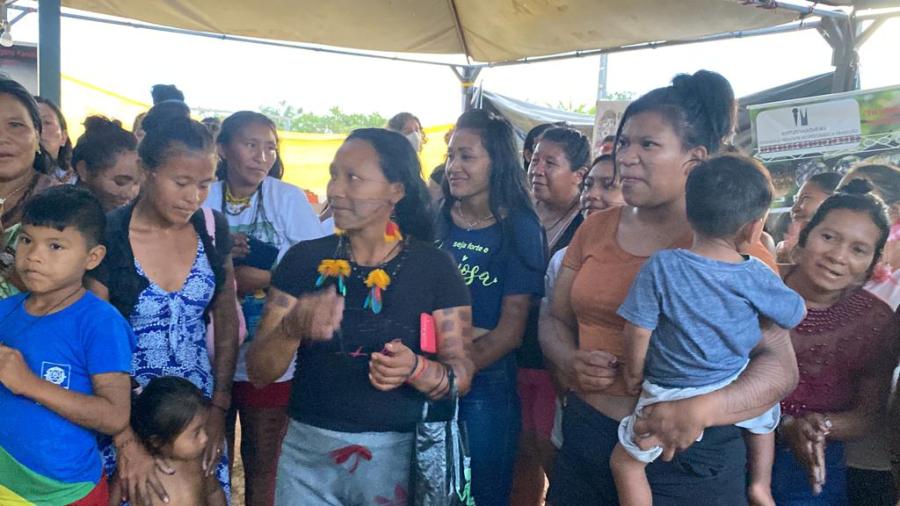
ANMIGA: Working to Eliminate Violence Against Indigenous Women in Brazil
- Nov 25, 2022
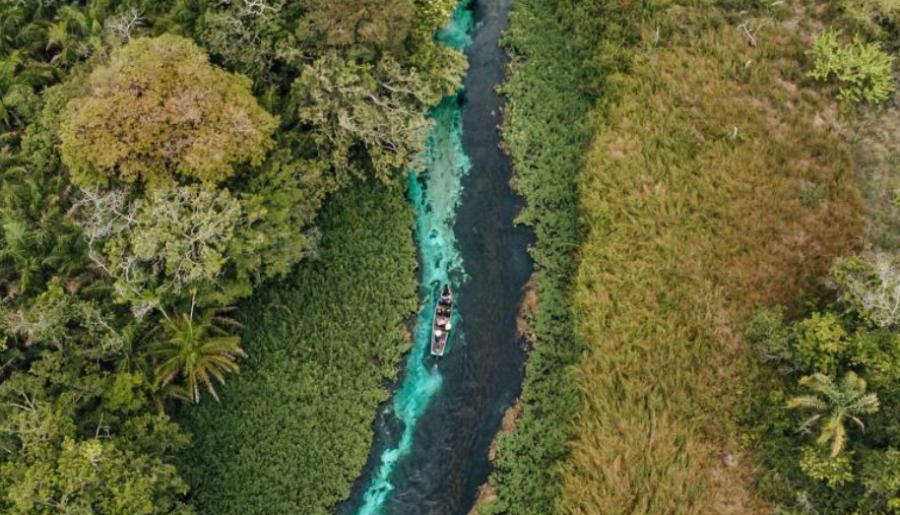
Report Honors Lives Lost of 13 Indigenous Defenders and Highlights Emerging Regions of Risk in Brazil
- Nov 15, 2023
Our website houses close to five decades of content and publishing. Any content older than 10 years is archival and Cultural Survival does not necessarily agree with the content and word choice today.

Land Acknowledgement We acknowledge that we are headquartered on Massachusett land , in Cambridge, MA, and we thank the past, current, and future Indigenous stewards of this territory.
Our Mission
Cultural Survival advocates for Indigenous Peoples' rights and supports Indigenous communities’ self-determination, cultures and political resilience, since 1972.
Cultural Survival envisions a future that respects and honors Indigenous Peoples' inherent rights and dynamic cultures, deeply and richly interwoven in lands, languages, spiritual traditions, and artistic expression, rooted in self-determination and self-governance.
Stay Informed
Sign up today to stay informed about the latest news, Cultural Survival program updates, events and MORE...
- Cultural Survival E-Newsletter - News and Updates
- Bazaars and Events
- Information on conferences, meetings and global events pertaining to Indigenous Peoples
- Free digital CSQ Magazine
© 2023 Cultural Survival. All Rights Reserved. | Donor Privacy Policy | EIN: 23-7182593
Heilbrunn Timeline of Art History Essays
Musical instruments of the indian subcontinent.
A Lady Playing the Tanpura
Tanjore Tāmbūra (male)
Taūs (mayuri)
Pandharpuri Tambura
Ghanti (bell)
Murari Adhikari
Allen Roda Independent Scholar
The music of the Indian subcontinent is usually divided into two major traditions of classical music: Hindustani music of North India and Karnatak music of South India, although many regions of India also have their own musical traditions that are independent of these.
Both Hindustani and Karnatak music use the system of ragas—sets of pitches and small motives for melody construction—and tala for rhythm. Ragas form a set of rules and patterns around which a musician can create his or her unique performance. Likewise, tala is a system of rhythmic structures based on the combination of stressed and unstressed beats. Within these rhythmic structures, musicians ( 1996.100.1 ) can create their own rhythmic patterns building off the compositional styles of others.
One of the main differences between North Indian and South Indian music is the increased influence of Persian music and musical instruments in the north. From the late twelfth century through the rise of British occupation , North India was under the control of a Muslim minority that was never able to extend its sphere of influence to South India. During this time, the music of North India began to acquire and adapt to the presence of Persian language, music, and musical instruments, such as the setar, from which the sitar got its name; the kamanche ( 1998.72 ) and santur, which became popular in Kashmir; and the rabab (alternately known as rebab and rubab), which preceded the sarod. New instruments were introduced, including the tabla and sitar ( 1999.399 ), which soon became the most famous Indian musical instruments worldwide. Legend has it that the tabla was formed by splitting a pakhavaj drum in half, with the larger side becoming the bayan and the smaller side the dahini. The barrel-shaped pakhavaj drum, which was the ancestor of both the tabla and the mrdangam, has been depicted in countless paintings and prints. New genres of music were formed as well, such as khyal and qawwali , that combine elements of both Hindu and Muslim musical practice.
Hindustani classical music is known largely for its instrumentalists, while Karnatak classical music is renowned for its virtuosic singing practices. Instruments most commonly used in Hindustani classical music are the sitar, sarod, tambura, sahnai, sarangi, and tabla; while instruments commonly used in Karnatak classical music include the vina, mrdangam, kanjira, and violin . The use of bamboo flutes, such as the murali, is common to both traditions as well as many other genres of Indian music. In fact, many of these instruments are often used in both North and South India, and there are many clear relationships between the instruments of both regions. Furthermore, often instruments that are slightly different in construction will be identified by the same name in both the south and the north, though they might be used differently.
Throughout its history, the peoples of India have developed numerous systems for classifying musical instruments, many of which were based on morphological characteristics. The ancient Hindu system divided instruments into four categories: stretched (strings; 2008.141.2a,b ), covered (drums; 89.4.165 ), hollow (wind; 1986.12 ), and solid (bells; 89.4.154 ). This system is widely known to be the inspiration for the Western system of instrument classification put forth by Mahillon in 1880, which renames these groups—chordophones, membranophones, aerophones, and idiophones—basing the distinction on the way in which sound is created and not exclusively on construction.
A note on spelling : All terms used for Indian musical instruments and musical concepts are common transliterations of the original terms. Subsequently, there are numerous possible methods of rendering the same term in English and inevitable discrepancies in spelling. The spellings adopted here are the ones used by The New Grove Dictionary of Music and Musicians (2001).
Kanjira (Khanjari) The kanjira is a frame drum of South India. It consists of a skin (usually iguana) stretched and pasted on a circular wooden frame. There are often three or four slots in the side of the frame, in which bell-metal jingle-disks are suspended from metal crossbars. The name kanjira is related to the khanjari and kanjani of North and East India and Nepal. The kanjira is tuned to various pitches by wetting the skin. It is held at the bottom of the frame by the left hand, which also varies the tension of the skin, and is beaten with the fingers of the right hand.
Kamanche The kamanche is one of the world’s earliest known bowed instruments. It has been altered and changed as it has traveled to other parts of the world ( 1998.72 ). Some argue that the kamanche is the predecessor of many other stringed instruments such as the rabab, the sarangi, and the Chinese erhu.
Mrdangam The mrdangam is an elongated barrel-shaped drum found predominantly in South India ( 1986.467.18 ). It is derived from the pakhavaj and is used as the primary rhythmic accompaniment in Karnatak music as well as in religious Kirtan music. In the east (Bengal, Odisha), this barrel-shaped drum is known as the khol.
Murali The murali is a transverse flute made of bamboo. It is used in a variety of musical genres and is often associated with the Hindu deity Krishna.
Pakhavaj The pakhavaj is a barrel-shaped drum with two heads, each of which contains tuning paste, or siyahi . The history of the pakhavaj is unknown, yet as the predecessor of both the Hindustani tabla drums and the mrdangam of Karnatak music, it served as the primary accompaniment for much of Indian classical music. It appears in the musical iconography of Hindu religious painting and in the artworks of the royal Muslim courts of the Mughal empire.
Rabab The rabab is a stringed instrument with a skin-covered resonator that can be bowed or plucked depending on performance tradition. It is found in various forms throughout North Africa, the Near East, South Asia, and Central Asia. Similar to the way the setar and the vina were adapted to eventually become what is known today as the sitar, the rabab was adapted to become the sarod. However, there are many musicians in India today who still play the rabab, and it is quite popular in several music genres.
Sahnai (Shenai) The sahnai is a double reed instrument of North India and Nepal. In South India, a double reed instrument called the nagasvaram is used. Both instruments have seven equidistant fingerholes and no thumbhole. Frequently, the instrument’s flared open end is made of metal while its body is made of wood or bamboo; however, they are not exclusively made in this fashion.
Sarangi A sarangi is a bowed stringed instrument with a skin-covered resonator ( 89.4.200 ). The typical sarangi is made by hand, usually from a single block of tun wood about 66 to 69 centimeters long ( 46.34.43 ). The three playing strings are made of goat gut, and the sympathetic strings (usually as many as thirty-six, though the number varies) of brass and/or steel. However, the design of sarangis varies from region to region ( 1982.143.2 ). For example, the Nepalese sarangi is generally much smaller than its Indian counterpart, and not all sarangis have sympathetic strings.
Sarod The sarod is a relatively new instrument to South Asia, having been around for less than 200 years. The sarod is a plucked stringed instrument with a skin-covered resonator and sympathetic strings. Like the sitar, it is primarily used in Hindustani music and is accompanied by the tabla.
Setar The word setar means “three strings.” Other instruments in this family include the two-stringed dutar and the single-stringed ektar. As Indian musicians adopted the setar, they added more and more strings. Early sitars, which evolved from the setar, have six strings, while more contemporary ones include six playing strings and thirteen sympathetic strings. A Persian setar in the Museum’s collection is a miniature that was made primarily for the purpose of decoration. Many such instruments exist in India.
Sitar The sitar is easily India’s most famous musical instrument overseas, having been popularized in the West by George Harrison of the Beatles, who studied with Ravi Shankar, one of the greatest sitarists of the twentieth century. The sitar has its roots in both the Persian setar as well as in the vina. Like many stringed instruments used in classical Indian music, the modern sitar ( 1999.399 ) has sympathetic strings that sound only when one of the primary strings is struck on the same note. These strings, which are never played by the performer, resound in sympathy with the playing strings, creating a polyphonic timber that many have come to associate with India through the popularity of this instrument. It is interesting to note, however, that the addition of the sympathetic strings is a relatively recent development in Indian music starting in the late nineteenth century ( 89.4.1586 ). The use of sympathetic strings is known to have existed in other parts of the world prior to their initial use in India.
Tabla The tabla is actually two drums played by the same performer. Both drums have compound skins onto which a tuning paste, or siyahi , is added to help generate the wide variety of tones these drums can produce. The bayan is the larger of the two drums and is generally made of metal or pottery. The siyahi on the bayan is off-center, which allows the performer to add variable pressure on the skin, changing the pitch of the instrument with the palm of his or her hand while striking it with the fingertips. The smaller drum is called the dahini, or sometimes referred to as the tabla. Dahini are usually made of heavy lathe-turned rosewood and provide much higher pitch sounds than does the bayan.
Tambura The tambura is a long, stringed instrument made of light hollow wood, with either a wooden or a gourd resonator. It is typically used in accompaniment with other instruments, providing a drone pitch. Some of the tamburas in the Museum’s collection are not full-sized instruments, but rather miniatures created for their aesthetic appearance. The artistic craftsmanship on the inlay in these objects is beautiful. India has a long history of creating musical instruments as decorative objects, and that tradition is represented in the Museum’s collection.
Vina Along with the pakhavaj, the vina is one of the most commonly depicted instruments in Indian iconography. The vina has taken many forms in both South and North India. In North India, it was called the bin or the rudravina, and was the predecessor of the sitar. It was often built of two large gourd resonators connected by a piece of bamboo, with frets held on with wax. Most of the vinas depicted in iconography are rudravinas. In the South, the vina—or saraswati vina—continues to be the most popular stringed instrument in classical music. In its basic shape, the vina is a hollow wooden stringed instrument with two gourd resonators (though there can often be more than two or sometimes only one gourd resonator). The gottuvadyam, or chitravina, is another important instrument in Karnatak music. Unlike the rudravina and the saraswati vina, the gottuvadyam has no frets and is played with a slide using a method similar to that of the Hawaiian slide guitar .
Roda, Allen. “Musical Instruments of the Indian Subcontinent.” In Heilbrunn Timeline of Art History . New York: The Metropolitan Museum of Art, 2000–. http://www.metmuseum.org/toah/hd/indi/hd_indi.htm (March 2009)
Related Essays
- Company Painting in Nineteenth-Century India
- Hinduism and Hindu Art
- Musical Terms for the Seventeenth and Eighteenth Centuries
- Poetic Allusions in the Rajput and Pahari Painting of India
- Recognizing the Gods
- The Art of the Mughals after 1600
- The Art of the Mughals before 1600
- Indian Textiles: Trade and Production
- Jain Sculpture
- The Metropolitan Museum’s Excavations at Nishapur
- Modern Art in India
- Music in the Ancient Andes
- Musical Instruments of Oceania
- The Nature of Islamic Art
- Nepalese Painting
- Nineteenth-Century Classical Music
- Nineteenth-Century Court Arts in India
- Postmodernism: Recent Developments in Art in India
- Postmodernism: Recent Developments in Art in Pakistan and Bangladesh
- South Asian Art and Culture
- Violin Makers: Nicolò Amati (1596–1684) and Antonio Stradivari (1644–1737)
List of Rulers
- List of Rulers of South Asia
- South Asia, 1400–1600 A.D.
- South Asia, 1–500 A.D.
- South Asia, 1600–1800 A.D.
- South Asia: North, 1000–1400 A.D.
- South Asia: North, 500–1000 A.D.
- South Asia: South, 1000–1400 A.D.
- South Asia: South, 500–1000 A.D.
- Mother-of-Pearl
- Musical Instrument
- Plant Fiber
- Southeast Asia
Artist or Maker
- Adhikari, Murari
- Amati, Nicolò
Online Features
- MetMedia: Alap in Raag Desh performed by K.V. Mahabala

Model IELTS Task 2 essay: Traditional Music
Aug 14, 2020 | IELTS , IELTS Test , IELTS Writing

Below you will find a model essay for an IELTS Academic or General Writing Task 2 question.
It is a slightly edited version of an essay written by one of our students. This is the standard you can achieve when you take lessons with us .
This essay is likely to score from 8.5-9.0 on test day. This is a two-part question , and we have used the following template…
Introduction: with our position Body Paragraph 1: answering the first question Body Paragraph 2: answering the second question Conclusion: repeating our position
You can see a more general and detailed template for Task 2 questions on this page. We have also written a more detailed analysis of how to answer the different Task 2 question types here .
The Question
There are many different types of music in the world today.
Why do we need music?
Is the traditional music of a country more important than the international music that is heard everywhere nowadays?

Humans have long sought to harness the expressive power of music to convey their feelings. It is inconceivable to imagine a human civilisation without its own traditional musical instruments. However, due to globalisation, many people fear that national and traditional music will be eroded by the international industry. I agree with this stance, and I believe that more efforts should be made to maintain the musical heritage of diverse cultural groups.
Music has played a central role in shaping people’s cultural identity. For this reason, music is deemed to be an indispensable tool, through which a sense of belonging can be developed among younger generations. An excellent example of this role is national anthems which are played at national events. Additionally, music is a repository of the collective memory of people, and this is why composers have deployed their musical prowess to narrate and record history. If we allow international music to be embedded within our culture, we will dilute our sense of belonging.
It might be argued that younger generations should be acquainted with different musical traditions to develop tolerance towards other cultures. Others think that broadening our musical horizons can enrich our traditional music by infusing it with various genres of music. I agree with these views; however, a priority should be given to local musical traditions in our national curriculum. To maintain the diversity of humanity’s musical heritage, children should be taught how to play their own inherited musical instruments.
In conclusion, over the span of our history, music has played a pivotal role in developing a sense of belonging among the young. However, the changes that are wrought by the globalised music industry can weaken our traditions and heritage. As such, greater space should be given to local music in education systems worldwide.
If you would like to answer the same question and receive feedback, purchase one of our Writing Correction Packages .
If you would like to watch a video about how to write IELTS General Task 2 essays, visit this page .
See how an examiner marks a Task 2
Purchase a Writing Correction
Meet your tutor
Return to IELTS Essay Home Page
Return to Blog
Guide on How to Write a Music Essay: Topics and Examples

Let's Understand What is Music Essay
You know how some school assignments are fun to write by default, right? When students see them on the course syllabus, they feel less like a burden and more like a guaranteed pleasure. They are about our interests and hobbies and therefore feel innate and intuitive to write. They are easy to navigate, and interesting topic ideas just pop into your head without much trouble.

Music essays belong to the category of fun essay writing. What is music essay? Anything from in-depth analysis to personal thoughts put into words and then to paper can fall into a music essay category. An essay about music can cover a wide range of topics, including music history, theory, social impact, significance, and musical review. It can be an analytical essay about any music genre, musical instruments, or today's music industry.
Don't get us wrong, you will still need to do extensive research to connect your opinions to a broader context, and you can't step out of academic writing standards, but the essay writing process will be fun.
In this article, our custom essay writing service is going to guide you through every step of writing an excellent music essay. You can draw inspiration from the list of music essay topics that our team prepared, and later on, you will learn what an outstanding essay on music is by an example of a music review essay.
What are Some Music Topics to Write About
There are so many exciting music topics to write about. We would have trouble choosing one. You can write about various music genres, be it country music or classical music; you can research music therapy or how music production happens.
Okay, forgive us for getting carried away; music makes us enthusiastic. Below you will find a list of various music essay topics prepared from our thesis writing service . Choose one and write a memorable essay about everyone's favorite art form.
Music Argumentative Essay Topics
Music essays can be written about an infinite number of themes. You can even write about performance or media comparison.
Here is a list of music argumentative essay topics. These edge-cutting topics will challenge your readers and get you an easy A+.
- Exploring the evolution of modern music styles of the 21st century
- Is it ethical to own and play rare musical instruments?
- Is music therapy an effective mental health treatment?
- Exploring the Intersection of Technology and Creativity in electronic music
- The Relevance of traditional music theory in modern music production
- The Role of musical pieces in the Transmission of cultural identity
- The value of historical analysis in understanding the significance of music in society
- How does exposing listeners to different genres of music break down barriers
- Exploring the cognitive effects of music on human brain development
- The therapeutic potential of music in treating mental disorders

Why is Music Important Essay Topics
Do you know which essay thrills our team the most? The importance of music in life essay. We put our minds together and came up with a list of topics about why music is so central to human life. Start writing why is music important essay, and we guarantee you that you will be surprised by how much fun you had crafting it.
- Popular Music and its Role in shaping cultural trends
- Music as a metaphorical language for expressing emotions and thoughts
- How music changes and influences social and political movements
- How the music of different countries translates their history to outsiders
- The innate connection between music and human beings
- How music helps us understand feelings we have never experienced
- Does music affect our everyday life and the way we think?
- Examining the cross-cultural significance of music in society
- How rock music influenced 70's political ideologies
- How rap music closes gaps between different racial groups in the US
Consider delegating your ' write my essay ' request to our expert writers for crafting a perfect paper on any music topic!
Why I Love Music Essay Topics
We want to know what is music to you, and the best way to tell us is to write a why I love music essay. Below you will find a list of music essay topics that will help you express your love for music.
- I love how certain songs and artists evoke Memories and Emotions
- I love the diversity of music genres and how different styles enrich my love for music
- I love how music connects me with people of different backgrounds
- How the music of Linkin Park helped me through life's toughest challenges
- What does my love for popular music say about me?
- How the unique sounds of string instruments fuel my love for music
- How music provides a temporary Release from the stresses of daily life
- How music motivates me to chase my dreams
- How the raw energy of rock music gets me through my daily life
- Why my favorite song is more than just music to me
Need a Music Essay ASAP?
Our expert team is quick to get you an A+ on all your assignments!
Music Therapy Essay Topics
One of the most interesting topics about music for an essay is music therapy. We are sure you have heard all the stories of how music cures not only mental but also physical pains. Below you can find a list of topics that will help you craft a compelling music therapy essay. And don't forget that you can always rely on our assistance for fulfilling your ' write my paper ' requests!
- The effectiveness of music therapy in reducing stress and pain for cancer patients
- Does pop music have the same effects on music therapy as classical music?
- Exploring the benefits of music therapy with other genres beyond classical music
- The potential of music therapy in aiding substance abuse treatment and recovery
- The Role of music therapy in Addressing PTSD and Trauma in military veterans
- The impact of music therapy on enhancing social interaction and emotional expression in individuals with developmental disabilities
- The use of music therapy in managing chronic pain
- Does musical therapy help depression?
- Does music reduce anxiety levels?
- Is music therapy better than traditional medicine?
History of Music Essay Topics
If you love analytical essays and prefer to see the bigger picture, you can always write a music description essay. Below you can find some of the most interesting topics for the history of music essay.
- The Significance of natural instruments in music production and performance
- Tracing the historical development of Western music theory
- How electronic music traces its roots back to classical music
- How the music industry evolved from sheet music to streaming services
- How modern producers relate to classical composers
- The Origins and Influence of Jazz Music
- How folk music saved the Stories of unnamed heroes
- Do we know what the music of ancient civilizations sounded like?
- Where does your favorite bandstand in the line of music evolve?
- The Influence of African American Music on modern pop culture
Benefits of Music Essay Topics
If you are someone who wonders what are some of the values that music brings to our daily life, you should write the benefits of music essay. The music essay titles below can inspire you to write a captivating essay:
- How music can be used to promote cultural awareness and understanding
- The benefits of music education in promoting creativity and innovation
- The social benefits of participating in music groups
- The Impact of Music on Memory and Learning
- The cognitive benefits of music education in early childhood development
- The effects of music on mood and behavior
- How learning to play an instrument improves cognitive functions.
- How music connects people distanced by thousands of miles
- The benefits of listening to music while exercising
- How music can express the feelings words fail to do so
Music Analysis Essay Example
Reading other people's papers is a great way to scale yours. There are many music essay examples, but the one crafted by our expert writers stands out in every possible way. You can learn what a great thesis statement looks like, how to write an engaging introduction, and what comprehensive body paragraphs should look like.
Click on the sample below to see the music analysis essay example.
How to Write a Music Essay with Steps
Writing music essays is definitely not rocket science, so don't be afraid. It's just like writing any other paper, and a music essay outline looks like any other essay structure.

- Start by choosing a music essay topic. You can use our list above to get inspired. Choose a topic about music that feels more relevant and less researched so you can add brand-new insights. As we discussed, your music essay can be just about anything; it can be a concert report or an analytical paper about the evolution of music.
- Continue by researching the topic. Gather all the relevant materials and information for your essay on music and start taking notes. You can use these notes as building blocks for the paper. Be prepared; even for short essays, you may need to read books and long articles.
- Once you have all the necessary information, the ideas in your head will start to take shape. The next step is to develop a thesis statement out of all the ideas you have in your head. A thesis statement is a must as it informs readers what the entire music essay is about. Don't be afraid to be bold in your statement; new outlooks are always appreciated.
- Next, you'll need a music essay introduction. Here you introduce the readers to the context and background information about the research topic. It should be clear, brief, and engaging. You should set the tone of your essay from the very beginning. Don't forget the introduction is where the thesis statement goes.
- One of the most important parts of essay writing is crafting a central body paragraph about music. This is where you elaborate on your thesis, make main points, and support them with the evidence you gathered beforehand. Remember, your music essay should be well structured and depict a clear picture of your ideas.
- Next, you will need to come up with an ideal closing paragraph. Here you will need to once again revisit the main points in your music essay, restate them in a logical manner and give the readers your final thoughts.
- Don't forget to proofread your college essay. Whether you write a long or short essay on music, there will be grammatical and factual errors. Revise and look through your writing with a critical mind. You may find that some parts need rewriting.
Key Takeaways
Music essays are a pleasure to write and read. There are so many topics and themes to choose from, and if you follow our How to Write a Music Essay guide, you are guaranteed to craft a top-notch essay every time.
Be bold when selecting a subject even when unsure what is research essay topic on music, take the writing process easy, follow the academic standards, and you are good to go. Use our music essay sample to challenge yourself and write a professional paper.
If you feel stuck and have no time our team of expert writers is always ready to give you help from all subject ( medical school personal statement school help ). Visit our website, submit your ' write my research paper ' request and a guaranteed A+ essay will be on your way in just one click.
Need Help in Writing an Impressive Paper?
Our expert writers are here to write a quality paper that will make you the star of your class!
FAQs on Writing a Music Essay
Though music essay writing is not the hardest job on the planet, there are still some questions that often pop up. Now that you have a writing guide and a list of essay topics about music, it's time to address the remaining inquiries. Keep reading to find the answers to the frequently asked questions.
Should Artists' Music be Used in Advertising?
What type of music is best for writing an essay, why do people love music, related articles.
.webp)
*Your language will be set using a browser cookie.
Log in to Music in Africa
- Login with Facebook
- Login with Google
Don't have an account? Sign up
Forgot your password?
All Artists & Industry (47 034)
Artists (33 986).
- Bands /groups
- Composers, arrangers & songwriters
- Choirs, orchestras & ensembles
- Session artists
- Solo artists
- Sound artists
- Spoken word
Artist Service Providers (6 947)
- Video Producers
- Legal Experts
- Audio Engineers
- Collecting Societies
- Distributors
- Marketing Experts
- Recording Studios
- Record Labels
Events & Venues (3 525)
- Event Suppliers
Archives & Media (2 948)
- TV channels
- Publications
- Radio Stations
Music Education (2 490)
- Primary & secondary schools
- University departments
- Community music centres
- Online educators
- Private tutors
Organizations, Networks & Associations (3 642)
- Culture development
- Legal/copyrights
- Production & Technical
- Associations

You are here
Traditional music in ethiopia.
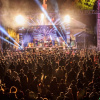
By Fitsum Getachew
Ethiopia has a long and at times tormented history. With that it has an equally long and fascinating history of arts and culture. To write about Ethiopia’s traditional music in one article such as this may not do justice to everyone nor reveal the complete and true picture of the situation. This text should thus simply serve as a launch pad for further study for anyone who would like to venture deeper into the country’s traditional music.
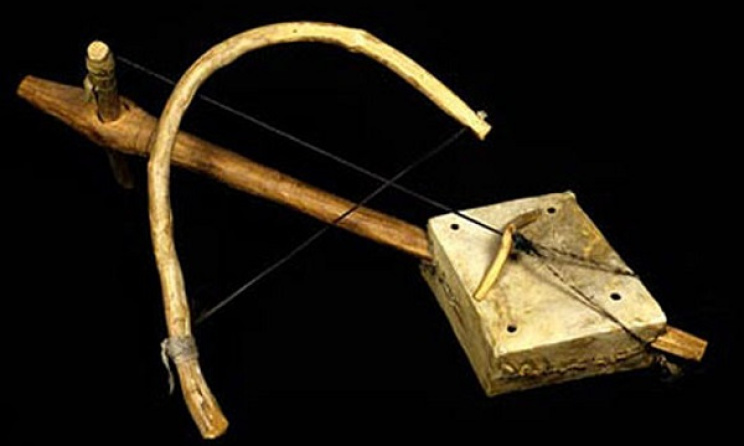
The music of Ethiopia is a reflection of all the historical and social episodes, such as the military campaigns that various warlords or chiefs had to launch. The music is about war as well as patriotism, songs of victory, songs that incite support for a certain crusade. The music is also about love, with wonderful melodies and poetic lyrics. The spirituality of Ethiopians is expressed in the form of music. All these types of tunes and melodies are prepared and performed using various traditional instruments.
Traditional instruments
Ethiopian traditional music is best expressed with its musical instruments, besides the contribution of the renowned vocalists. The most characteristic and widely used instruments are the masinko , the krar , the washint , the begena , the kebero , and the tom-tom .
The masinko is a single-stringed instrument that is used in many parts of the country by several people, including the Amhara, the Tigreans and Oromo. The masinko as it is a kind of fiddle made from the tail of horses and a piece of hide. It is relatively easy to make and is played by rubbing a bow made of a string against the fiddle. People in the Ethiopian highland areas learn to play the masinko at a very early age, particularly in the north around Gondar. Verses are typically created by the vocalist and player of the instrument - or as is the tradition, the audience suggests poems or lyrics and the vocalist just repeats them word for word. Among the greatest masinko specialists in Ethiopia was Getamessay Abebe, who used to be a leading member of the Ethiopian Orchestra [i] , a traditional musical group founded in 1963. The group attained prominence when Charles Sutton, a US Peace Corps member fascinated by the instrument, joined the group and learnt to play one. The group subsequently toured the US, introducing Ethiopia’s traditional music at concerts. Other influential masinko players include Legesse Abdi (in Oromiffa language), Adane Teka and Habtemichael Demissie, while Alemayehu Fanta more recently played Amharic songs using the single-stringed instrument.
The masinko is one of the most popular traditional music instruments used throughout Ethiopia and one of the fixtures in Ethiopian music and culture. Although it looks simple, the masinko can, in the hands of an expert musician, produce a wide variety of melodies. It is often played by wandering minstrels, as well as professional musicians, particularly at restaurants and local bars called 'Bunna Bet'. The word 'Azmari' is derived from the Geez word 'Zemmari', which means “one who sings”. Today, the concept mainly applies to establishments where professional masinko players perform accompanied by female singers.
The krar is a traditional lyre [ii] with five strings. A conversation about the krar cannot come to an end without mentioning the name of Kassa Tessema. Kassa was a prominent krar player who made a name for himself with patriotic hymns such as 'Fano Fano' and love songs such as 'Shegitu'. Asnakech Worku [iii] , often referred to as ‘the Queen of krar’ (1933-2011) had the krar as her trademark. Even though she was an actress, Asnakech was known for her skills with the krar , along with her quick wit and inspired improvisations.
The begena [iv] or Ethiopian harp is an instrument mostly used for spiritual purposes. Among the most popular players of this instrument is Alemu Aga, along with Alemayehu Fanta. Spiritual hymns are mainly heard during fasting periods for Orthodox Christians when people express their devotion to God.
The washint or the flute is another widely used traditional musical instrument. It is typically played by Ethiopian shepherds while herding cattle. The bamboo flute usually has four to six holes. Ethiopian youth learn to play this instrument at a very early age. Yohannes Afework, a member of the famous Orchestra Ethiopia of the 1960s, and Animut Kinde are among the most popular players of this instrument.
The Ethiopian drum or kebero is used to accompany the traditional tunes that Ethiopians play. The drum enriches most songs, which would be not as interesting to listen to without the drum beat. The double-headed kebero drum is also used in the traditional music of Eritrea and Sudan. A piece of animal hide is stretched over each end of the instrument, thus forming a membranophone. A large version of the kebero is also used in Ethiopian Orthodox Christian liturgical music, while smaller versions are used in secular celebrations. A special kind of drum referred to as tom-tom is used in the south-western part of the country, in Gambella Region. The beating of drums in general is very characteristic of the fast songs played in the south of the country, where you have the Kenbata, Hadiya, Gedeo, Sidama and others performing their colorful, traditional belly dances that are reminiscent of the Middle Eastern or Arabic dancers.
Traditional dances
The various tribes and ethnic groups of Ethiopia have their own distinct music, cultures and traditions. According to some analysists, Ethiopian dances are not divided according to their function but rather according to their uniqueness and individuality. Therefore, there are over 150 unique dance movements across Ethiopia.
For example, the Tigrayans to the north have a smooth, circular dance routine characterised by shoulder and neck movements. The Amharas at the centre of the country have a dance style dominated by upper body and neck movements. The Oromos at the centre and south have a jumping style and full-bodied dance routine. The Gurages have an acrobatic dance that requires high levels of arm, leg and body coordination. The Welayita, Kenbata, Sidama, Dawro and others among the peoples of the South Region have very attractive belly dances that are hugely popular throughout the nation. The beats are quite rhythmic and fast.
The Ethiopian term e skista [v] means 'dancing shoulders'. This type of dance is predominantly practiced in the northern parts of Ethiopia, where the indigenous tribes of Amhara, Wollo, Gojjam, Gondar and Shoa are still performing the dance. The motives and characteristics of the dance often vary according to the performers and the context, for example war songs, hunting songs, shepherd songs, love songs and work songs. The best dancer is typically appointed to the leader of the group and/or the best singer. The eskista dance brings the dancer into a role as story-teller, who then expresses with his or her body the cultural traditions and life of the community. The dance, as well as the music and singing, serve as symbolical messages of Ethiopian society as a whole.
Venues and clothing
Traditional music is still alive and well in Ethiopia. There are many stages for traditional music in various cities, but the main ones are to be found in the capitalm the tourist towns of Bahir Dar and Gondar and elsewhere in the north of the country. In Addis you have Yod Abyssinia, 2000 Habesha and Fendika among the most renowned venues, while in Bahir Dar and Gondar, as well as Enfranz area outside Gondar itself, there are a plethora of houses where both tourists as well as locals who are on vacation can enjoy traditional Ethiopian music.
Ethiopian traditional music is performed with the appropriate attire, depending on the region one represents. In the north, clothes made of cotton are usually worn. In the south and west, clothes made of animal skins or hides are more common. The traditional shemma of the northern people is typically made of cotton and is usually white. This relates to the Amhara and Tigreans predominantly. In the Oromo culture, singers use clothes made of hides or skins, while male dancers wear lion’s fur on their heads. In the southern dances, performers wear colourful clothing decorated by various patterns and woven with cotton. In most cases female dancers are full of ornaments around their neck and arms. In the south there are often visible tattoos on the dancer’s face.
Ethiopia contains many distinct cultures. The most populous is that of the Christian Amhara around the capital plateau, but there are other Christian, Jewish and Muslim people, some of them remote and virtually unknown. Sung verses of poetry are a common feature in Amhara. The poetry’s basic formats together with the ambiguities in phrasing have something in common with poetic forms in Yemen and serve principally to attract interest. The words they use may often have a double meaning - perhaps one that is stated overtly, the other a hidden meaning.
While more modern or westernized Ethiopian music has drawn international attention, partly on account of its clear link with American jazz traditions, there have only been a handful of recordings illustrating Ethiopian traditional music over the years. These have not done enough to give a full representation of the depth and variety of traditional music in Ethiopia.
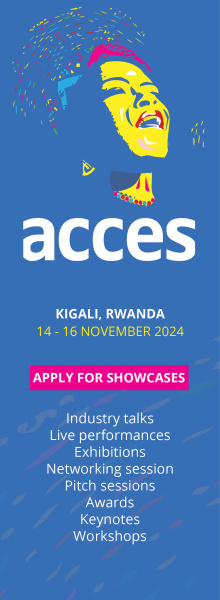
Most popular

Sabu Jiyana and Matimba Project

Pole Classic
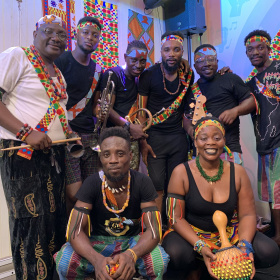
Audrey Bading M

Amanie Illfated
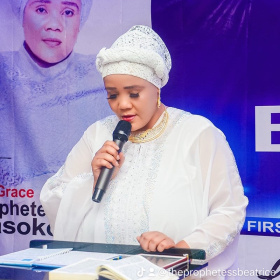
Prophetess Beatrice

South African Music Performance Rights Association (SAMPRA)

Aliant Qais Conrad Laureate
Related articles.
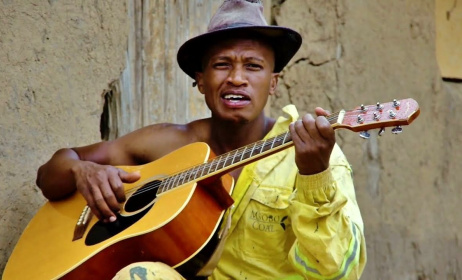
- ACCES Music Conference
Disclaimer: Music In Africa provides a platform for musicians and contributors to embed music and videos solely for promotional purposes. If any track or video embedded on this platform violates any copyrights please inform us immediately and we will take it down. Please read our Terms of Use for more.
- previous play next repeat
IELTS Mentor "IELTS Preparation & Sample Answer"
- Skip to content
- Jump to main navigation and login
Nav view search
- IELTS Sample
IELTS Writing Task 2/ Essay Topics with sample answer.
Ielts essay # 94 - is the traditional music of a country more important than the international music, ielts writing task 2/ ielts essay:, there are many different types of music in the world today. why do we need music is the traditional music of a country more important than the international music that is heard everywhere nowadays.
- IELTS Essay
- Writing Task 2
- IELTS Writing Task 2
IELTS Materials
- IELTS Bar Graph
- IELTS Line Graph
- IELTS Table Chart
- IELTS Flow Chart
- IELTS Pie Chart
- IELTS Letter Writing
- Academic Reading
Useful Links
- IELTS Secrets
- Band Score Calculator
- Exam Specific Tips
- Useful Websites
- IELTS Preparation Tips
- Academic Reading Tips
- Academic Writing Tips
- GT Writing Tips
- Listening Tips
- Speaking Tips
- IELTS Grammar Review
- IELTS Vocabulary
- IELTS Cue Cards
- IELTS Life Skills
- Letter Types

- Privacy Policy
- Cookie Policy
- Copyright Notice
- HTML Sitemap
Talk to our experts
1800-120-456-456
- Music Essay

Essay on Music
Music is like a universal language of life. It is basically the sound that is brought together through the harmony of various instruments. Our life would have been totally empty and different without music. It is something that every human being enjoys. It is a very powerful thing. Music helps to destress, heal, and motivate.
If you are looking for a short essay on music, then take a look at the short essay given in the following. This is created by the in-house exports of Vedantu keeping the understanding ability of the students. Those who are looking for references can look up to this following essay. It will be easy to figure out the pattern of how to write an essay on music. One can also download the Vedantu app to get access to the same file.
Music Essay for Students
“Without music, life will be a mistake” the statement of Friedrich Nietzsche, a German philosopher, simplified the importance of music in one’s life so easily. Music has a magical impact on humans. It's the best form of magic.
The origin of the word ‘music’ is the Greek word ‘mousike’ which means ‘art of muses’. Music is a form of art and artists decorate it. The music consists of lesser words with deeper meanings. Frequently people use music as a painkiller to escape from the pain of life. ‘Musical Notations’ is the leading form to write music. This provides a reference to an artist so he can share with others if necessary. Music is a mood freshener and accompanies us in our pocket devices, on televisions, movies, and the most effective in live concerts.
Different forms of music have different effects on human nature. Music is the greatest creation of mankind in the course of history. A combination of deem lights and calm music encourages the listener to eat less and enjoy the food more. Listening to music positively in a car influences one’s mood leads to safer behaviour and fewer road rages ultimately minimising accidental destructions.
If the students love the music, it helps them in recalling the information more significantly along with improvement in verbal intelligence. The studies have found that listening to favourite songs helps fibromyalgia patients to experience less chronic pain. Music has a direct effect on our hormonal levels. Listening to music decreases the level of the hormone cortisol in our body and counteracts the effect of chronic stress.
The heart-touching music is nothing but creativity with the purest and undiluted form. The combination of vocal or instrumental sounds in such a way that it produces beauty and expresses emotions. Anyone can make their day by enjoying music by listening or by composting or by playing. The global facts say parents intensively use music to soothe children even to interact.
Music touches the heart through the ears. It has divine power to act as an energy booster. Some music assists in motivation while some play the best role in sympathy. Music helps us to fight insomnia. Listening to classical or relaxing music, just before going to bed, improves one’s sleep.
Though music helps to counteract depression and loneliness, people underestimate the impact of music on the human mindset in the age of irony age. On the other side of the coin, there are some types of music that can result in deleterious effects on the human mind and body. Listening to music with high decibels can damage neurons. The effect on the brain subjected to continuous exposure to electronic amplification of rhythmic music is similar to that of drugs.
Genres of Music
While talking about a wide variety of music that ranges from ages belonging to different places, cultures, and types, the list of genres is endless. However, some of the major genres of music are stated as below:
Folk & Traditional Music
Traditional music holds an impression of the culture that it represents. It is usually illustrated and sung with folk music. Folk music is taught by one generation to another vocally through singing it and by listening to it. Various dance performances are in order to make it stay intact through ages. In India, the state of Rajasthan is well known for its Traditional-folk music with its dance. Several other regions are also popular.
Art music describes the characteristics of both classical and contemporary art forms. It is usually sung by just one person and demands a high level of attention from its listeners. It is quite well known in Europe.
Religious Music
The type of music that is affiliated to the worshipping of God by singing it, is known as Religious Music. Every religion has its own style and way of singing it. Christian music is one of the most famous religious music known all over the world.
Popular Music
As the name suggests, the type of music that is popular and accessible to everyone and everywhere is known as Popular Music. Such music is composed mostly by the entertainment industry for the purpose of monetary income. As compared to other types of music, Popular Music attracts a notable audience through different concerts or Live shows.
It has gained immense popularity over a period of time and varies from country to country and from culture to culture. One can listen to it on public platforms, digital platforms, television commercials, radio, and even at shopping centres.
Popular music can be subcategorized into numerous types such as Hip Hop Music, Rock Music, Polka Music Music, Jazz Music, Pop Music Latin Music, Electronic Music, Punk Music, and many more. Among different types of Popular Music, Hip Hop Music is vividly famous, especially among the youth population. The culture of Hip Hop music originally started in New York City and now has taken over its place everywhere. The culture of Hip Hop dance has also emerged because of the same. With passing time, a lot of changes are happening in the field of Music but it will never go out of style.
Music is a healer to all human emotions from sadness to depression. It is a cause of happiness. Music content has many genres to play. Emotional expressions have been regarded as the most important criteria for the aesthetic value of music. Sometimes, some crises of life are impossible to express in proper sentences and their music plays its best part. Log on to Vedantu to find exciting essays on other topics and learn how to frame one perfectly from experts.

FAQs on Music Essay
1. What Role Does Music Play in Our Life?
Music is a very important part of our life as it is a way to express our feelings as well as emotions. For some people, music is a way to escape from all the pain. It gives you relief and allows you to destress yourself. Music plays a crucial role in our life rather than just being a source of entertainment. More importantly, music is something that can be enjoyed by everyone irrespective of their caste, creed, age, or gender.
2. Why is Music So Powerful?
Music is a language of emotion in that it can represent different feelings of a soul without any boundaries or limitations. When people feel really low and think that no one understands them, they listen to music. It is a good weapon to imitate emotions and reduce them. Music is something that can be felt from within our soul. Music is connected with Nature. There are numerous incidents of various singers where singing had led towards the showering of rains.
3. How Can I Write an Essay on Music?
Get to know the topic. You can't start writing about music until you've familiarised yourself with the concept. Do research thoroughly. Understand the important points and jot them down. Then draw a structure and start writing an essay. A student needs to realise the importance of music and the belonging of its culture for a better understanding and ease of writing. Talking to different artists from this field may also help in writing the essay. Refer to this essay framed by the experts of Vedantu and compile on your own.
4. Is Music a Means of Therapy?
In this modern era where everyone is busy living their hectic life, music plays an important role in soothing one’s mental health. Over a course of time, it has been scientifically proven that music acts as a therapy for a person suffering from depression or anxiety. Even the sound of waves in the ocean helps to heal a person mentally. Thus, psychologists suggest hearing calm and soothing to gain relief from worldly distress.
Essay on Music for Students and Children
500+ words essay on music.
Music is a vital part of different moments of human life. It spreads happiness and joy in a person’s life. Music is the soul of life and gives immense peace to us. In the words of William Shakespeare, “If music is the food of love, play on, Give me excess of it; that surfeiting, The appetite may sicken, and so die.” Thus, Music helps us in connecting with our souls or real self.

What is Music?
Music is a pleasant sound which is a combination of melodies and harmony and which soothes you. Music may also refer to the art of composing such pleasant sounds with the help of the various musical instruments. A person who knows music is a Musician.
The music consists of Sargam, Ragas, Taals, etc. Music is not only what is composed of men but also which exists in nature. Have you ever heard the sound of a waterfall or a flowing river ? Could you hear music there? Thus, everything in harmony has music. Here, I would like to quote a line by Wolfgang Amadeus Mozart, one of the greatest musicians, “The music is not in the notes, but in the silence between.”
Importance of Music:
Music has great qualities of healing a person emotionally and mentally. Music is a form of meditation. While composing or listening music ones tends to forget all his worries, sorrows and pains. But, in order to appreciate good music, we need to cultivate our musical taste. It can be cited that in the Dwapar Yug, the Gopis would get mesmerized with the music that flowed from Lord Krishna’s flute. They would surrender themselves to Him. Also, the research has proved that the plants which hear the Music grow at a faster rate in comparison to the others.
Get the huge list of more than 500 Essay Topics and Ideas
Magical Powers of Music:
It has the power to cure diseases such as anxiety, depression, insomnia, etc. The power of Music can be testified by the legends about Tansen of his bringing the rains by singing Raag Megh Malhar and lighting lamps by Raga Deepak. It also helps in improving the concentration and is thus of great help to the students.
Conclusion:
Music is the essence of life. Everything that has rhythm has music. Our breathing also has a rhythm. Thus, we can say that there is music in every human being or a living creature. Music has the ability to convey all sorts of emotions to people. Music is also a very powerful means to connect with God. We can conclude that Music is the purest form of worship of God and to connect with our soul.
FAQs on Essay on Music:
Q.1. Why is Music known as the Universal Language?
Ans.1. Music is known as the Universal language because it knows no boundaries. It flows freely beyond the barriers of language, religion, country, etc. Anybody can enjoy music irrespective of his age.
Q.2. What are the various styles of Music in India?
Ans.2. India is a country of diversities. Thus, it has numerous styles of music. Some of them are Classical, Pop, Ghazals, Bhajans, Carnatic, Folk, Khyal, Thumri, Qawwali, Bhangra, Drupad, Dadra, Dhamar, Bandish, Baithak Gana, Sufi, Indo Jazz, Odissi, Tarana, Sugama Sangeet, Bhavageet, etc.
Customize your course in 30 seconds
Which class are you in.

- Travelling Essay
- Picnic Essay
- Our Country Essay
- My Parents Essay
- Essay on Favourite Personality
- Essay on Memorable Day of My Life
- Essay on Knowledge is Power
- Essay on Gurpurab
- Essay on My Favourite Season
- Essay on Types of Sports
Leave a Reply Cancel reply
Your email address will not be published. Required fields are marked *
Download the App


- Products search
- Vietnam Classic Tours
- Vietnam Family Tours
- Vietnam Adventure Tours
- Tailor-Made Tours
- Vietnam Attractions
- Vietnam Travel Guide
Tradition & Culture
Vietnamese traditional music | hundred years of history & culture.
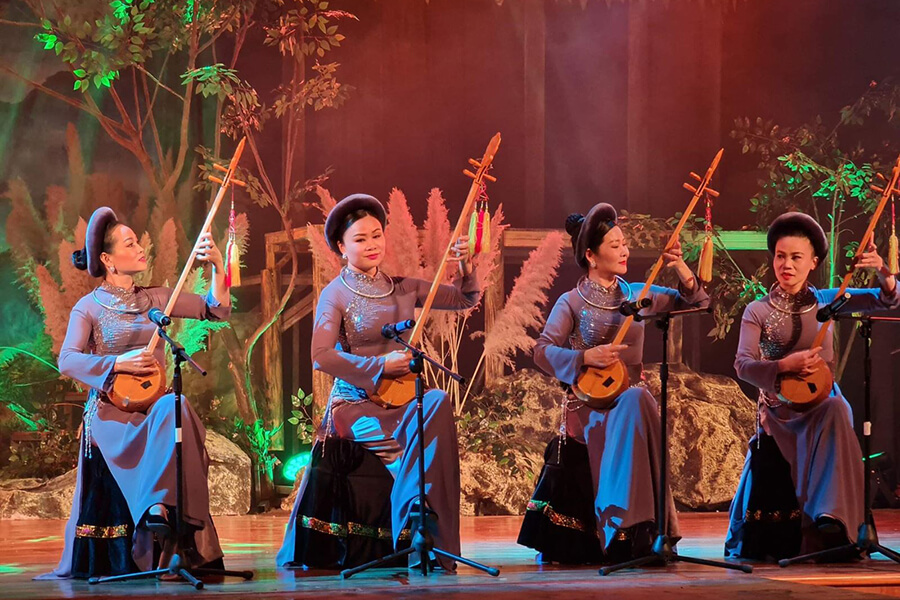
Vietnamese traditional music or folk music is one major branch of Vietnamese music, truly reflecting the typical characteristics of people, culture, customs, geography, etc. of Vietnam, stretching throughout the history of the nation. Since the 20th century, Vietnamese music has been influenced by the foreign music styles such as China, Korea, the United States, United Kingdom but it still keeps its unique beauty, which is shown in the existence of Vietnamese traditional music as well as playing an important role in the culture in Vietnam.
An Overview of Vietnamese Traditional Music
Vietnamese traditional music was born very early. Ever since ancient times, Vietnamese people have been very passionate about music and considered music an integral part of their life. Therefore, in the process of historical development, the residents have constantly created many musical instruments and musical genres to express their feelings and emotions, gain more motivation for daily work, and get out of the stress in life. You can listen to the melody of lullabies, children’s songs, types of music in worshiping rituals, funerals, or conversations among members of the community, in entertaining activities, perform in singing contests, epics, the sweet songs of the jongleurs, “Don Ca Tai Tu” – the traditional music of the Southern people, and the traditional opera, etc.
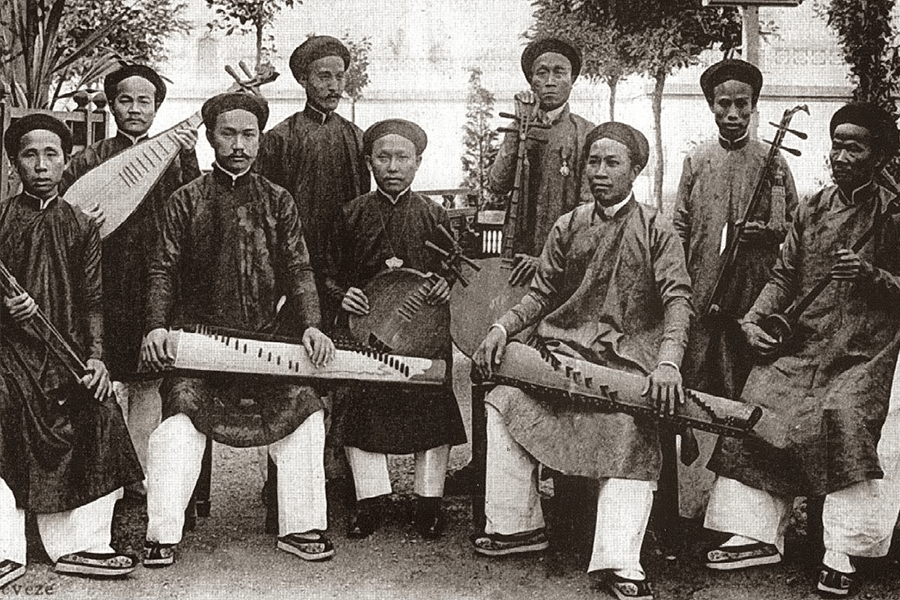
Vietnamese traditional music is rich by the accumulation of genres not only of different ages but also of numerous ethnic groups. Although having the same genre of music, each ethnic group has a distinctive mode of expression, performance, and cadence. For example, the lullabies of the Kinh are different from those of the Thai, the Muong, the Dao, etc. Moreover, some ethnic groups use lullabies to sing their children to sleep while others play a diversity of traditional musical instruments such as flute, Vietnamese monochord, and so on.
Vietnam has 54 ethnic groups, which means that there are 54 different traditional musical backgrounds. Therefore, in this article, we would like to mention the traditional music of the Kinh people – the dominant ethnic group in Vietnam, accounting for 85.7% total of the population.
There are various ways to classify Vietnamese Traditional Music (here, Kinh’s music). In terms of types of music, they have: Royal family music, Cheo, Tuong, Xam singing, Don Ca Tai Tu, folk songs, Ca Tru, etc. If divided by regions, they have: the traditional music of the South; the Central, the Central Highlands, the North, and so on or smaller by regional culture. For the number of performers, it can be divided into the single, duo, in a group.
In Vietnamese traditional music, it is extremely common for the artists to use a variety of traditional music instruments: dan bau (Vietnamese monochord), dan co (Vietnamese erhu), dan day, dan nguyet (moon lute), etc. All of these musical instruments contribute to creating unique characteristics of Vietnamese traditional music.
Types of Vietnamese Traditional Music
Types of vietnamese traditional music in northern vietnam, ca trù (hát ả đào).
Ca trù, also known as hát ả đào, is one type of chamber music that was extremely popular in North and North Central Vietnam since the 15th century. It used to be court music that was loved by the aristocrats and the intellectuals. Besides, it can be said that Ca trù is a perfect combination of poetry and music.
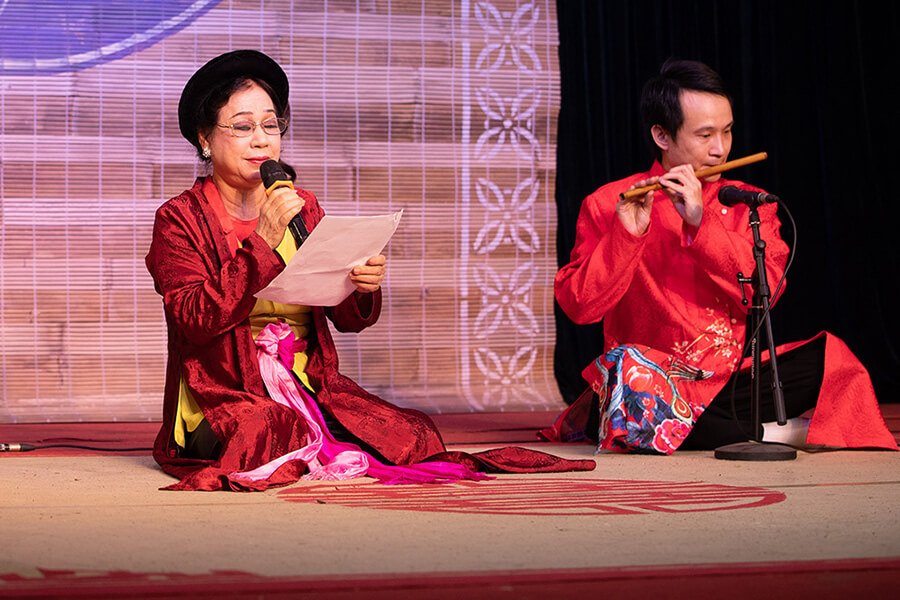
There are three main characters in a Ca trù performance: a female singer (called “đào” or “ca nương”) who uses the tongs, a male instrumentalist (called “kép”) who plays dan day to support the vocalist, a spectator (called “Quan viên”, usually being the author of the song) who plays the drum to punctuate the song and express the pleasure by the drum sound. In 2009, Ca trù was recognized as an intangible heritage that requires urgent protection by UNESCO.
Hát Văn or Chầu Văn is one of the types of Vietnamese traditional music, that originated in the North Delta. It is associated with Mother Goddesses Worship – the very famous folk belief in Vietnam. By using spiritual music with solemn and elaborate words, Chầu văn is considered to be a singing form of worshiping the goddesses.

Chầu Văn plays an extremely important role in a Mother Goddesses Worshiping performance to invite the gods to attend the ceremony. During the performance, the singers can sing and play musical instruments at the same time for 4-8 hours, creating a bustling atmosphere for the ceremony. The music instruments usually consist of dan nguyet (moon lute), small drums, tongs, cymbals, flute, Vietnamese monochord, etc. Hát văn is well-known in Hanoi and Nam Dinh, but the performing style in Nam Dinh is more rustic than that in Hanoi.
Chèo is a form of Vietnamese traditional stage art, strongly developing in North Vietnam, especially in the Red River delta and two sparsely populated mountainous areas in the North and North Central. This type of folk music has a harmonious combination of ethnicity and popularity with narrative and romantic lyrics so it is amazingly preferable for summer festivals.
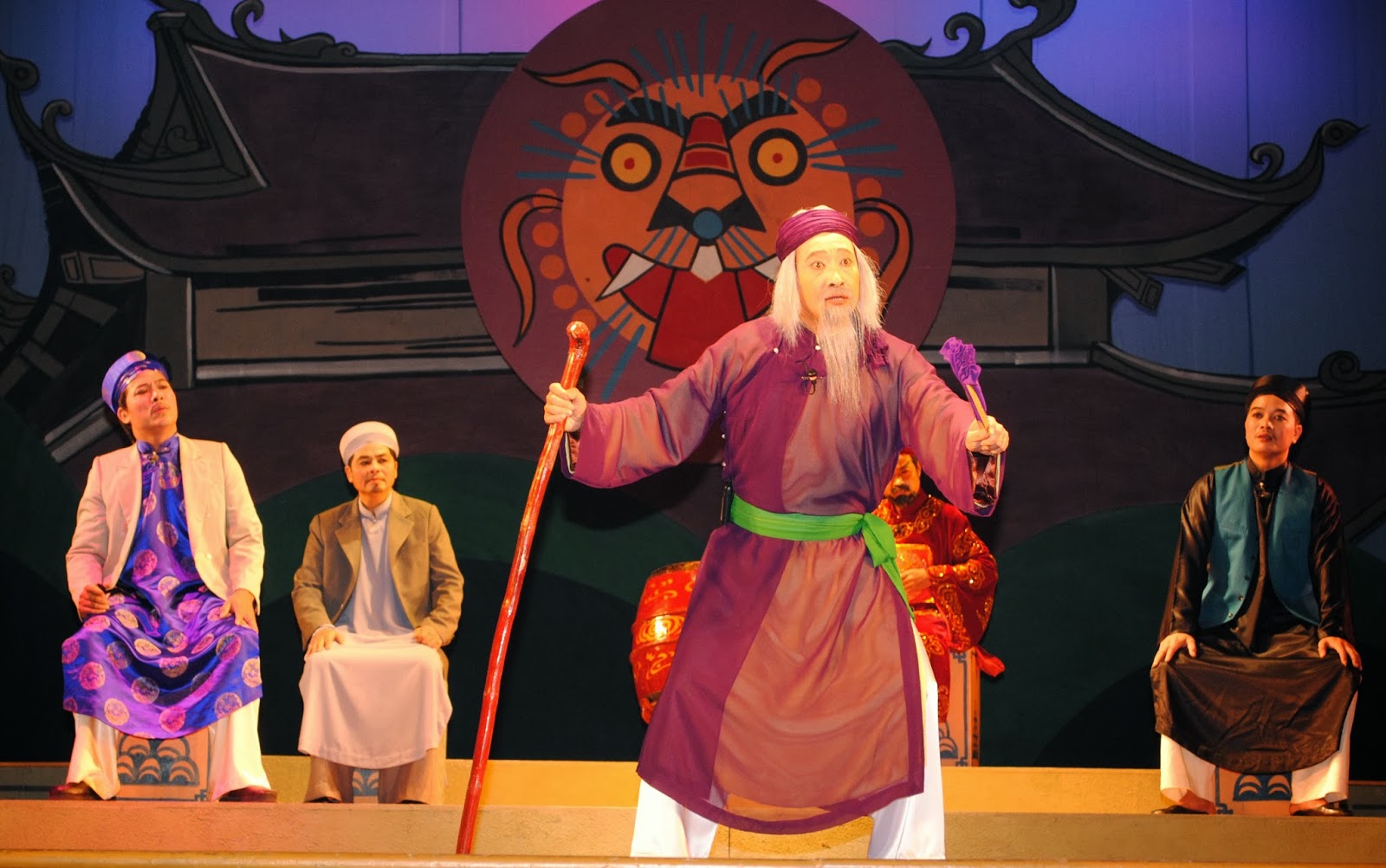
Chèo stage art has undergone a long history from the 10th century to the present, having a deep influence on Vietnamese social life. In terms of the meaning, Chèo reflects all aspects of the national identity of the Vietnamese people: optimistic, loving, simple, full of national pride, persistent in fighting against the invaders to protect the country. Thanks to these great meanings, Chèo is full of literary genres: romantic, epic, poetic, etc. creating a unique attraction for this traditional music.
Quan Ho Folk Songs
Quan ho is one of the typical folk songs of the Red River delta in the North of Vietnam. It was formed and developed in the ancient cultural area Kinh Bac, especially the area boundary between Bac Giang and Bac Ninh provinces today with the gently flowing Cau river called “the river of Quan ho”.
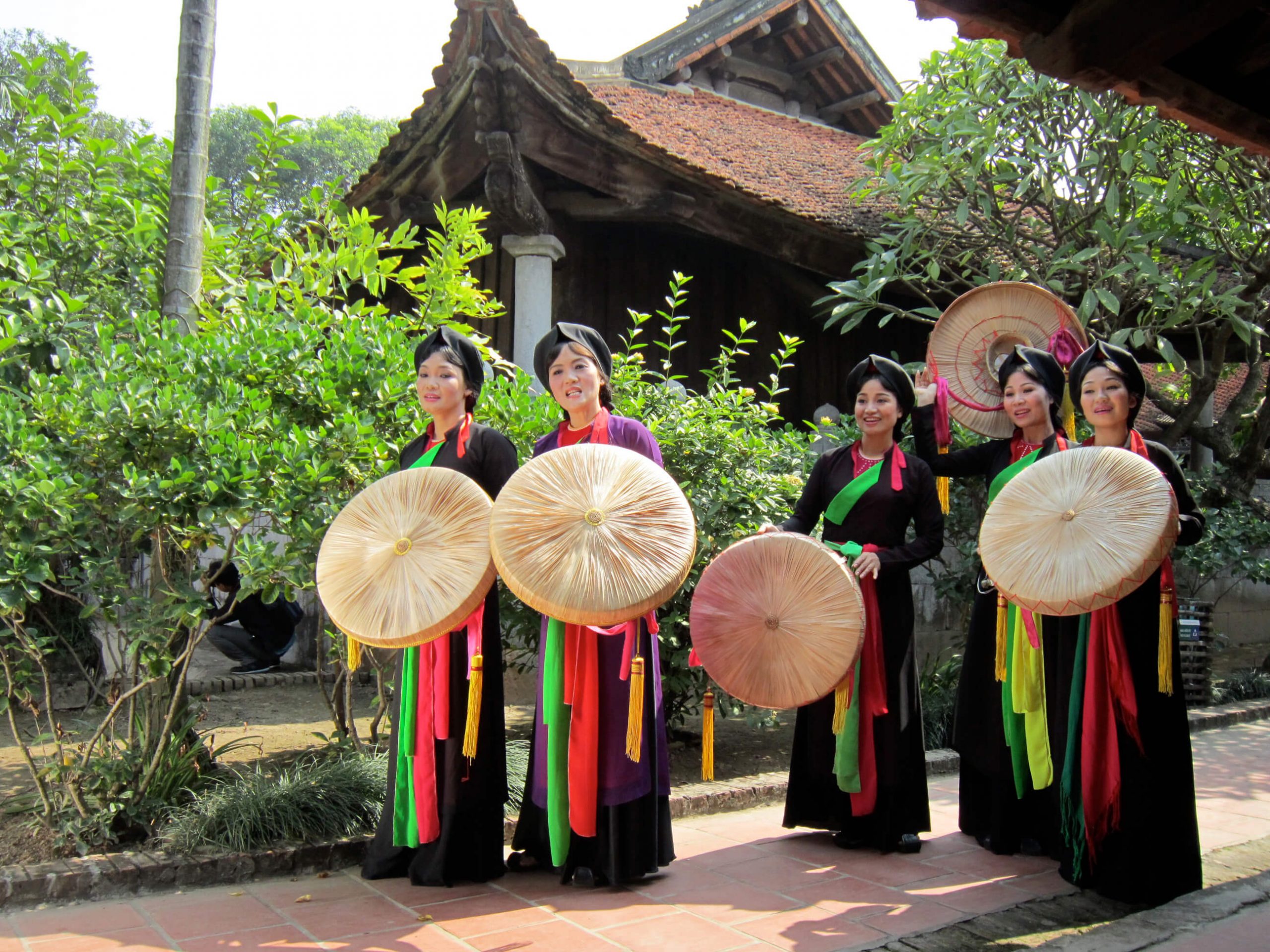
Quan ho folk songs are always performed in groups, each of which has five to six members. During the performance, they call each other the intimate names of the family members such as “Anh ca” (first brother), “Chi ca” (first sister), “anh hai” (second brother), and “chi hai” (second sister), etc. For this type of Vietnamese traditional music, the singers have their own performing costumes: the brothers with turbans, umbrellas, and tunics while the sisters are dressed up with “mo ba mo bay” shirts (a traditional cloth of the Vietnamese women) and large round hats and scarves. Quan ho folk songs impress the audience with an interestingly unique singing procedure. They usually divide into the “brother” group and “sister” group to sing back-and-forth the rustic and traditional loving songs with/without music accompaniment.
It is said that Tuồng is derived from the Vietnamese song and dance, but during its development, Tuồng has absorbed many forms of performance and makeup of traditional Chinese Opera. This kind of music usually expresses the majestic atmosphere to honor the national heroes, or to deliver the lessons of human behavior between community and individuals, between family and motherland. In a performance, the righteous forces have to fight for justice in very difficult conditions, becoming the bright mirror for the other people to follow.

Xẩm is one popular type of folk music in North Vietnam, especially in the Red River delta and Northern midland. In the past, Xẩm is considered a form of livelihood for the poor and the dead people, most of whom usually performed in markets, streets, or crowded places, but few performed on big stages so very few people know this traditional music. The music instruments to support Xẩm singing are also very simple, including Erhu and Senh Tien.
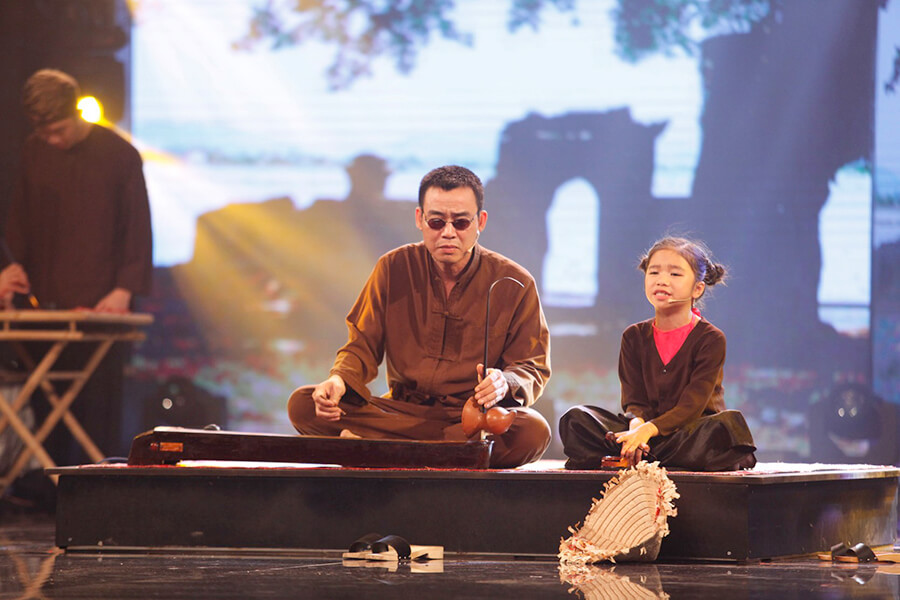
Until February 2013, Mrs. Ha Thi Cau – Ninh Binh province (1928-2013) who is supposed to be the last Xẩm singer of the 20th century went away, raising awareness of protecting this type of Vietnamese traditional music.
Types of Vietnamese Traditional Music in Central Vietnam
Hò, lý (chanty).
Hò and Lý are a popular musical genre in the Vietnamese people’s life from ancient times, originating from the living habits in the valley, depicting the mood and emotions of the laborers. These two types of Vietnamese traditional music are pretty similar to each other, but Hò is usually attached to a working movement while Lý is not. In addition, Hò and Lý have extremely been developing in Central and South Vietnam. Visiting these regions, you will find it easy to bump into the local people droning out the rustic genres of Hò and Lý.

Nhã Nhạc (Hue Royal Court Music)
Nhã Nhạc or Hue royal court music is the court music under feudal times, performed during festivals or ceremonies (coronation, funerals, and other religious festivals) in the reign of the Nguyen dynasty of Vietnam. Hue royal court music was recognized by UNESCO as a masterpiece of oral and intangible world cultural heritage in 2003.
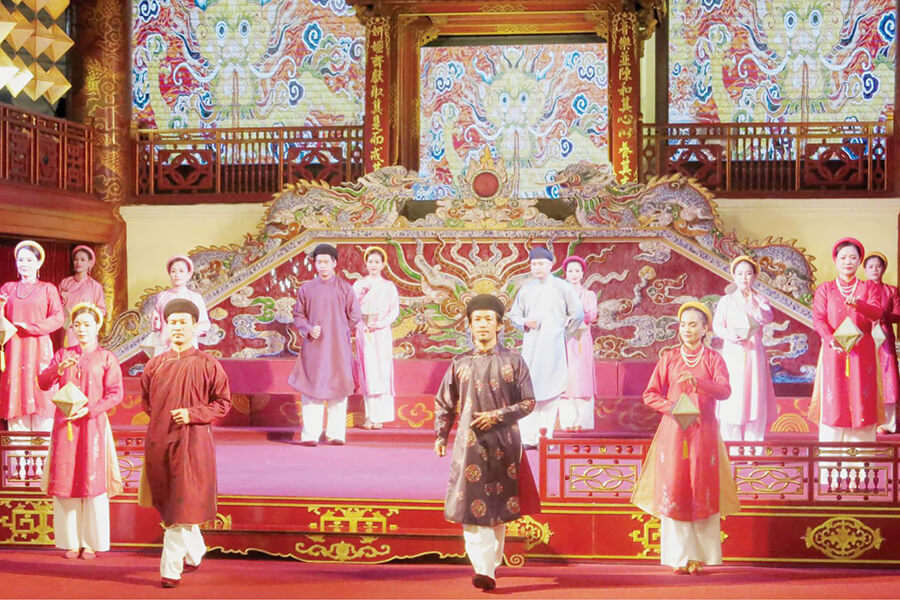
Nhã Nhạc has a diversity of 126 songs full of original lyrics and translations. Besides, there are hundreds of musical instruments supporting the Hue Royal court music performances. As a result, it is obviously to affirm that Nhã Nhạc is a type of Vietnamese traditional music with a tight structural system, partially contributing to creating: the complete structure of the orchestra, the system of orchestral music without lyrics, the music accompaniments for singing and dancing, the songs in different kinds of dance, and the songs in the ceremonies.
Types of Vietnamese Traditional Music in Southern Vietnam
Đờn ca tài tử (southern amateur music).
Đờn ca tài tử is the Vietnamese traditional music that was recognized as a world cultural heritage by UNESCO. It was established in the late 19th century, strongly developing and influencing 21 Northern provinces of Vietnam. This is one type of music combining lyrics and musical instruments, preferred by the Southern people in rural areas in their free time after a hard-working day.
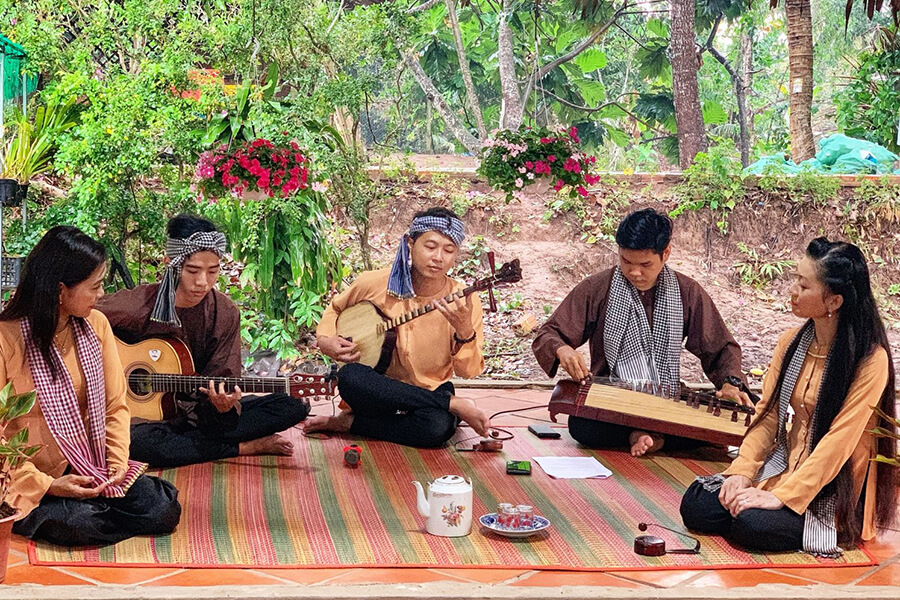
Đờn ca tài tử is over one hundred years old, usually known as the band performance, consisting of five Vietnamese traditional music instruments: dan tranh (zither), dan ty ba (pipa), dan nguyet (moon lute), dan bau (monochord), and dan tam; sometimes supported by the flute. The “đờn ca tài tử” singers are usually the friends or neighbors in a village; they gather and happily sing with each other so that they do not bother about the rustic costumes.
Cải lương is one kind of opera that originated in South Vietnam and was formed based on Đờn ca tài tử and the folk songs of the Mekong Delta. The content of each Cải lương performance may come from ancient Vietnamese stories, Nom poems, and literary works about Vietnamese society, and after that, the French scripts, Indian, Egyptian Romans, and Japanese ancient stories. The fusion of various cultures has shaped the special feature of this type of Vietnamese traditional music.
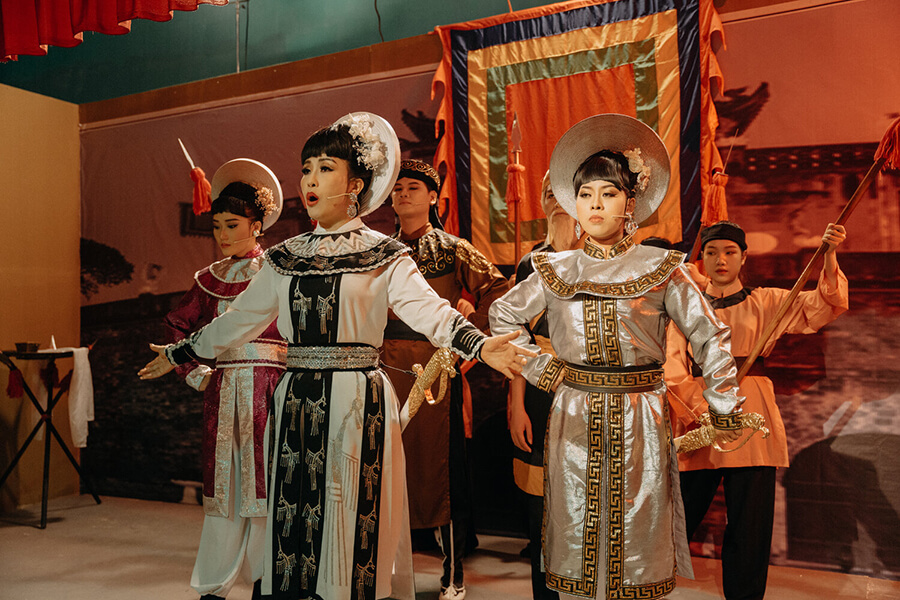
In addition, the performance of Cải lương will be not perfect without the musical accompaniment of the orchestra, which helps not only support the vocals but also highlight the psychological depth of the characters, creating more drama for the script, and contributes to the success of the play. Nowadays, Cải lương is also an extremely popular type of Vietnamese traditional music in the South, strengthening the spiritual life of the local people.
The above information includes a panorama of Vietnamese traditional music. During your Vietnam tour package , it will be an unforgettable memory to be one of the audience and enjoy some of the Vietnamese traditional music to have insight knowledge about Vietnamese culture.
If you fall in love with some kind of Vietnam traditional music, the show totally can be in your Vietnam tour packages, or you can click here for a tour package with the show you want:

Vietnam Highlights Tour – 21 Days
Tour Route: Hanoi - Halong Bay - Hue - Hoi An - Danang - Ho Chi Minh City - Vinh Long - Can Tho - Phu Quoc - Ho Chi Minh City.
Tour Highlights
- Explore the vibrant cities of Hanoi and Ho Chi Minh City, and cruise through the stunning landscapes of Halong Bay
- Visit Duong Lam and Bat Trang Village, the famous craft villages of Northern Vietnam
- Visit historical Hue and explore its imperial citadel and tombs
- Visit the charming town of Hoi An, exploring its ancient streets, temples, and renowned tailored shops
- Explore the Mekong Delta, including Vinh Long, Can Tho, and Phu Quoc Paradise Island

Northern Vietnam Beyond Tourist Trail
Tour Route: Hanoi - Hanoi Villages - Tam Chuc Pagoda Complex - Ninh Binh - Trang An - Halong Bay - Yen Duc Cultural Village - Hanoi
- Explore and immerse yourself in the rich traditions of craftsmanship found in the renowned craft villages of Northern Vietnam.
- Explore Tam Chuc Pagoda Complex, a sacred temple built with thousands of stone paintings
- Boat through mystical caves and lush landscapes at Trang An, Vietnam's "Halong Bay on land."
- Discover the historical sites of Hoa Lu Citadel and climb Mua Cave for a panoramic view of Tam Coc and Ninh Binh
- Cruise through Bai Tu Long Bay, visiting Thien Canh Son Cave and Vung Vieng Village
- Experience rural life in Yen Duc Cultural Village and Enjoy a Water Puppet Show by local artists

Authentic Adventuring Trail Across Vietnam
Tour Route: Hanoi - Duong lam Ancient Village - Ninh Binh - Bai Tu Long Bay - Hoi An - My Son Sanctuary - Vung Tau - Ho Chi Minh
- Immerse yourself in Hanoi's Old Quarter and visit Duong Lam Village, the famous craft villages of Northern Vietnam
- Discover the historical sites of Hoa Lu Citadel and climb Hang Mua for a panoramic view of Tam Coc and Ninh Binh
- Discover the diverse flora and fauna of Cuc Phuong National Park, one of Vietnam's oldest national parks.
- Cruise through the stunning Bai Tu Long Bay, visit caves and enjoy swimming and kayaking.
- Discover the ancient Cham civilization at the UNESCO-listed My Son Sanctuary.
- Experience the vibrant Mekong Delta and floating markets.
- Explore Vung Tau, starting with a visit to the impressive Jesus Statue for a panoramic view of the city.

The Amazing Vietnam Package Tour 16 Days
Tour Route: Hanoi - Ninh Binh - Trang An - Sapa - Ta Phin - Bai Tu Long Bay - Ky Son - Hue - Hoi An - My Son - Cu Chi Tunnels - Mekong Delta - Ho Chi Minh City
- Experience Hanoi's vibrant streets and dine with a Hanoi Street Foods.
- Trek through stunning landscapes in Coc Ly Market and Sapa, meeting local ethnic communities along the way.
- Cruise through Bai Tu Long Bay, visiting Thien Canh Son Vung Vieng village, Join Tai Chi classes and enjoy kayaking and cooking demonstration.
- Stay in a traditional homestay in Ky Son village and experience rural life
- Hoi An and Hue: Discover the ancient town, visit historical sites, and explore the vibrant markets.
- Experience the vibrant city life of Ho Chi Minh City and explore the Mekong Delta.

Absolute Vietnam – 15 Days
Tour Route: Ho Chi Minh City - Cu Chi Tunnels - Vinh Long - Can Tho - Hoi An - My Son Holyland - Hue - Hanoi - Ky Son Village - Duong Lam Village - Lan Ha Bay - Hanoi
- Explore the vibrant city of Saigon, visit historical sites, and experience the Cu Chi Tunnels.
- Visit one of the most vibrant floating markets on the Mekong Delta: Cai Rang floating market.
- Explore Hoi An's ancient town on a walking tour, Japanese Covered Bridge and Tan Ky old house.
- Visit Duong Lam, Ky Son Village, and cruise through the stunning landscapes of Lan Ha Bay.

Ultimate Vietnam Grand Tour – 28 Days
Tour Route: Hanoi – Sapa – Halong Bay – Danang – Nha Trang – Dalat – Buon Me Thuot – Pleiku – Ho Chi Minh City – Vinh Long – Can Tho – Mui Ne – Ho Chi Minh City
- Explore Hanoi’s culinary scene with local delights like Pho and Egg Coffee
- Trek through Muong Hoa Valley, discovering ancient rock fields and tribal villages
- Sail through Halong’s stunning landscapes, exploring Luon Cave and enjoying activities like kayaking
- Immerse in local life at Tra Que Village, take a river cruise, explore Hoi An’s ancient town and Vietnam’s Central Highlands and Southern wonders

Vietnam Serenity Journey – 20 Days
Tour Route: Ho Chi Minh City - Cu Chi Tunnels - Mekong Delta - Hue - Hoi An – Danang - Yen Tu - Ha Long - Sapa - Ha Noi
- Immerse yourself in the history and charm of Hoi An ancient town.
- Visit historical Hue and explore its imperial citadel and tombs.
- Journey to experience tranquility and serenity at Legacy Yen Tu.
- Explore the stunning beauty of Halong Bay on an overnight cruise.
- Experience breathtaking mountain views in Sapa, visit Cat Cat and Lao Chai villages.

Vietnam & Cambodia Cultural Tapestry – 20 Days
Tour Route: Hanoi - Sapa - Halong Bay - Hue - Hoi An - Ho Chi Minh - Vinh Long - Can Tho - Siem Reap - Phnom Penh
- Enjoy a water puppet show in Hanoi and take a night train to Sapa
- Embark on a Sapa village tour and visit Fansipan Peak
- Cruise through stunning view of Halong Bay
- Visit the Cai Rang Floating Market and join a Vespa night tour
- Discover Angkor Thom and Angkor Wat in Cambodia
- Visit Kampong Phluk Village and explore Phnom Penh's culture and history
2 thoughts on “ Vietnamese Traditional Music | Hundred Years of History & Culture ”
Hello, I will be travelling during August (1 to 10) to Hue, and would like to know if there are traditional music concerts or festivals during that period. My partner is practicing Dan Tranh (Vietnamese cithare) and we would like to attend such concert or festival. Thank you very much for your response Warm regards, Eric
Unfortunately, the biggest Hue festival in 2019 will be organized from 26/04 to 02/05. However, there is still small concerts or festivals taken place every month in Hue so enjoy your time in Vietnam.
Comments are closed.
Username or email address *
Password *
Remember me Log in
Lost your password?

100, 300, 400 & 1500 Word Essay on My Favorite Music
Table of Contents
My Favorite Music Essay 100 Words
There are many kinds of music such as pop music, country music, rock music, and the list goes on. However, my favorite music is piano music. Some people might not be familiar with piano music, but they prefer other kinds of music more. But to me, piano music is the finest of all music types.
I like piano music for two reasons. One is that music is played on a piano. The piano is my favorite musical instrument. I have a special liking for it, as I play piano for six years.
Moreover, the piano has its own elegance and dignity. Secondly, its melody relaxes and soothes me. After studying, I listen to the piano, for it reduces my stress and relaxes me. I enjoy piano music. It is also a way for me to be happy.
My Favorite Music Essay 300 Words
Music in the modern world is present everywhere. Around so many different musical styles: pop music, rap, alternative, rock, disco, techno, drum and bass, and, of course, immortal classics. Different people, depending on their tastes and preferences, like a variety of music.
Scientists say that by knowing a person’s musical preferences can determine their character. With this statement, I agree, because I think music can show nature and soul. For example, they believe that rock listeners are smart and sensible.
As for me, I like “Mill”. This group sings folk rock. Their repertoire includes Norwegian, Scandinavian, English, and other ballads. I like this band because of the unusual music and engaging lyrics. Each of their songs has a deep meaning and tells a story. They create a magical world populated by knights, Vikings, Valkyries, and many magical creatures. In addition, their soloist has an extraordinary voice. It seems to me that such a talent is born rarely.
I admire people who create music themselves. I, unfortunately, lack this talent. In my understanding, such people can show feelings, and draw pictures with their songs. They can make the listener laugh or cry, and think about the significance and eternal.
It is imperative that the music is good. I do not like it when it does not convey any meaning, except for primitive instincts. Unfortunately, modern pop music has gone along this path.
I think you cannot live without music. It is everywhere. I always listen to music regardless of my mood. She often helps me in everyday life. Dull household chores become easier and more fun under the right music track. A long road is brightened up by your favorite band. One contemporary poet wrote: “The world would be meaningless if the music were not present” – and I fully agree with him.
My Favorite Music Essay 400 Words
Out of all the various types of music we have studied, I would have to say my favorite type of music is from the mid to late 60s, 70s, and 80s eras. My favorite music style is rock & roll. To be specific I am talking about some of the music we studied in units 12, 13, and 18 of our textbook.
I like this style of music the highest because it represents who I am and what I enjoy. The lyrics to songs during these times were fun and easily understood. This was compared to other genres of early music that seemed very dark, depressing, or hard for me to understand or relate to.
In my opinion, rock and roll is easier to listen to and dance to, than other genres of music before the 1950s. This was mainly because the lyrics and the music prior to the ’50s were boring and very difficult to dance to. I am sure my opinion of this type of music before the 50s is based on my age and the time era I grew up in.
Rock and Roll have an excellent rhythm and a backbeat that sounds different from other early genres of music. It likewise has a blues influence which I like. Earlier genres of music, in my opinion, didn’t have the same type of rhythm, speed, syncopation, or strong backbeat, the riffs, and the hooks that rock & roll has. I also like the vocal range that some rock & roll musicians have and their ability to sound unique. From the early ’60s and on, the music sounded better. Rock and roll during these times also became more rhythmic.
In conclusion, I must say that it was very difficult for me to pick just one style of music or just two bands. There are so many other styles of music I enjoy listening to and numerous artists I appreciate. I could probably write forever naming all the musicians and different styles of music I enjoy.
It was also difficult for me to explain rock & roll specifically. This is because it contains many elements of different genres from some of the earlier music we studied. I just know that rock & roll wouldn’t have become what it is today if it weren’t for our musicians in the past. This has allowed us to learn and grow from them.
My Favorite Music Essay 1500 Words
It’s super challenging to pick a favorite kind of music for me because I love all music so much. When I was a child I always loved music, in dance class, I remember all the other girls had a difficult time finding the beat in the music but for some reason, I found it very easily and have always enjoyed dancing to music and it always made me very happy.
In general, music can have a big impact on people’s moods and is very effective. For example, relaxing music can calm some people when they are feeling angry but rock music can help them get their aggression out. Music affects everyone differently and everyone has a favorite kind or at least one they prefer more than the others.
Personally, my favorite genre is alternative music. Yes, I know that’s not exactly the most usual answer. Most people claim they prefer country or pop but not alternative! Well, I have my reasons for liking alternative the most, and once I explain I think you will understand quite clearly why I like alternative music the most.
First of all, I would like to say the hardest time I had doing this essay was deciding between techno and alternative. I love them both a ton. I finally decided on alternative but I finally settled on alternative because every song is unique and different in alternative.
That is why I am passionate about loving alternative music. First of all, I admire its uniqueness. Alternative genres are characterized by their uniqueness, hence their name. I love to hear what the artist come up with when they combine different musical genres together to create an unusual and new song.
I think that when artists do this they express themselves and show their ideas through their music. This makes it cooler and unique in its own way. That’s one of the main reasons I chose Alternative over all the other ones is because they are all pretty much the same.
Some of my favorite alternative songs are The Great DJ, Tiptoe, Bring Me to Life, Clocks, and Into the Ocean. All of these songs are different from each other and the other genera. Some of the songs are mixed with rock and pop music (for example, “Bring Me to Life”).
Things like that are why I love this genre because you never know what you’ll get and what it sounds like together. My favorite mixes are when they have rock, pop, and some mellow/relaxing music in their songs. This is because it’s so different and I am weird. I like action movie music because I want to be a director one day. I like to imagine when I’m listening to that kind of music some kind of action scene or something.
Some of my favorite artists that do some or all alternative are Coldplay, Neon Trees, Evanescence, Santigold, and Snow Patrol. These artists are my favorite because their ideas of how the music should sound or proceed after a verse are the same as mine. I really like listening to these artists when I am happy or angry. However, I usually listen to more relaxing music when I am upset, so they aren’t exactly the most suitable to listen to when I am sad.
However, listening has complications. Like I mentioned before I like to dance however with alternative music it is sometimes more difficult to dance to. This is because there isn’t always a consistent beat and the tune varies from slow and graceful to rock and fast.
However, if you just want to sit and listen to music and not think, an alternative works well. That’s the one thing about pop that I really enjoy is that you can dance to it or just pay attention to it. However, now that I really contemplate it you usually can’t help getting up and dancing when listening to pop so I guess it’s even. Other than the whole “hard to dance to” thing, the alternative is perfect for me.
My least favorite music is country. Don’t take offense if you like country because it’s nothing against you…probably…just kidding! I really don’t enjoy country music, especially the updated version of country. This is because all of the artist’s voices sound the same and so does pretty much everything else.
The tune varies slightly, but besides that, it’s the same old same old. And I don’t really like how they always sing about stuff like how their house was stolen by their ex-wife and then their Ford breaks down…again. I guess others might think I’m crazy and that not all songs are about stuff like that. Some of them are about ex-boyfriends who cheated on them.
They slashed holes in all four tires and took a sludge hammer to the headlights and carved their name in the seats. They did this so on and so forth. Truth is I actually listen to country music, but I have to really be in the mood for it like when we go on a deer hunt or something. But besides that, I pretty much think that country is Do Rae Me Fa which makes me laugh out loud. Again no offense to those country lovers out there.
Country is my least favorite genre, but hard rock aka rock and roll is right there with it. I have anger issues I’ll admit it but in hard rock, I like anger, hate, and…just plain screaming! I honestly can’t stand hard rock.
It is so ridiculously obnoxious that I just want to punch the guy with the Mohawk in the face so he shuts up! Most people who even want to listen to that are punk teenagers who are upset about their lives more than most teenagers. My dad also listens to it now that I think about it…but that’s just because he loves the 80s too much. Again just kidding…sort of…(nervous laugh) I love you, Dad!
After that, I think I may have a new least favorite…funny how reflection on things can change the order or place of something so fast. It’s also funny how ridiculously long it took me to write this thing. Okay back on track, I believe that the music you like depends on your personality. Also, I think music can affect your personality and as I mentioned, it certainly affects your behavior.
So whenever I am feeling depressed, I listen to music that is the opposite of what I’m experiencing, unless I’m happy. Sometimes though when I am upset or angry it would be pleasant to listen to the same feeling of music. Even if I am happy I still sometimes listen to sad songs just because I feel like doing it.
I think I really like the alternative because I’m able to get all feelings not just happy or sad or angry. Different songs, different meanings, different feelings. It’s just the genre that has it all. Due to how much music affects behavior, I avoid all songs that contain swearing and/or immoral language. I feel like songs like these are the very poorest and they are definitely my least favorite as far as individual songs are concerned.
I listen to all the songs I like during the week that I want, alternative, pop, etc. But there is one day when I only pay attention to one type of music. That day is Sunday and I only pay attention to gospel music (don’t think I’m being self-righteous or anything I swear I’m not trying to put it across that way) my point is, is that on Sundays I only tune in to songs that help me get closer to God. I like Come Thou Fount by Jenny Oaks Baker. I prefer instrumental hymns better than lyrics because they are more relaxing and I love instrument sounds, especially the violin.
By the time Sunday is over though I am more than ready to listen to my usual stuff. I feel like I listen to music all the time, 24/7, and I wouldn’t have it any other way. I love music so much that it is pretty much my whole life, which might not be a wise thing now that I think about it.
I am grateful for music. If I didn’t have it, I would probably be mentally unstable right now. In the past, music has always been there for me, especially when I was in a tough place and about to break mentally.
I just turned on my iPod and played some music. For example, right now I am trying to finish this without freaking out or breaking my computer because this is so long. I have my earbuds in and am listening to my alternative selections and am halfway through.
I would just like to conclude by saying that music has always had a big part in my life and I don’t know what I would do without it in mine. In summary, my main objective here is to show my love for alternative music and all music.
I also want to show how I use my music and other kinds of music. I hope that after this you will see why I like alternative music as well as simply all music so much. If not, I will have wasted what feels like a lifetime (though in reality, it has probably only been 6 hours). And that is my favorite type of music typed out into 5 extremely long pages.
100, 200, 400 & 500 Word Essay On Beat Plastic Pollution
100, 150, 200, 250, 300 & 500 Word Essay on Intellectual Property Rights
Leave a Comment Cancel reply
Save my name, email, and website in this browser for the next time I comment.

IMAGES
VIDEO
COMMENTS
Traditional music often incorporates traditional instruments, melodies, rhythms, and storytelling techniques that reflect the unique identity of a community. Section 2: Preserving Cultural Heritage
This essay aims to explore the importance of music and examine whether traditional music holds more significance than international music in today's globalized world. One of the primary reasons why we need music is its ability to evoke emotions and enhance our well-being. Music has a profound impact on our mood, relieving stress, and ...
Traditional songs, often called "folk songs," are learned informally, within the context of family, tribe, community, or another close-knit group. Many traditional songs have been sung within the same family or ethnic and regional communities for generations, and as in the case of American traditional songs, can sometimes be traced back to such places of origin as Great Britain, Europe, or ...
folk music, type of traditional and generally rural music that originally was passed down through families and other small social groups. Typically, folk music, like folk literature, lives in oral tradition; it is learned through hearing rather than reading.It is functional in the sense that it is associated with other activities, and it is primarily rural in origin.
This paper is a brief introduction to traditional music in Nigeria, particularly, amongst Nigeria's three major ethnic groups (Hausa, Igbo, and Yoruba). It covers a very short span in the evolution of these musical genres. Nonetheless, the paper. ... In this essay, the researcher observes that over generalization associated with the ...
This Very Short Introduction will guide and glide the reader through the main developments and issues of a topic with a simple name that covers complex layers of meaning and practice. It will not offer anything like a definition of "folk music," relying instead on the principle of "we know it when we hear it.".
The notion of 'traditional' music only emerges at the end of the 1800s with Dowling explaining over the course of Chapter 3 that prior to this the now so-called 'traditional' music was simply the 'popular' music of the time. However, in the context of the Anglo-Irish War this music gradually becomes part and parcel of the identity-building
This comprehensive essay traces the history and influence of Irish traditional music, and addresses its place in Irish society today. The author considers at length what constitutes the term 'Irish traditional music', as once it was simply the popular music of the masses. The essay is sub-divided into many selections, with audio samples provided throughout to complement the text.
Understanding Ethnomusicology. Ethnomusicology is the study of music in cultural context, and it encompasses a wide range of approaches and methods. Ethnomusicologists seek to understand how music is created, performed, and experienced within different cultures around the world. One key aspect of ethnomusicology is its focus on musical systems.
The repetitive, structured, often danced-with sounds of music are found in almost every society - along with language. There is something deeply human about music, but deeply cultural about it as well, for - like languages - there are many forms of music. Unlike language, however, music does not require "understanding."
Instruments most commonly used in Hindustani classical music are the sitar, sarod, tambura, sahnai, sarangi, and tabla; while instruments commonly used in Karnatak classical music include the vina, mrdangam, kanjira, and violin. The use of bamboo flutes, such as the murali, is common to both traditions as well as many other genres of Indian music.
music, art concerned with combining vocal or instrumental sounds for beauty of form or emotional expression, usually according to cultural standards of rhythm, melody, and, in most Western music, harmony.Both the simple folk song and the complex electronic composition belong to the same activity, music. Both are humanly engineered; both are conceptual and auditory, and these factors have been ...
Model IELTS Task 2 essay: Traditional Music. Aug 14, 2020 | IELTS, IELTS Test, IELTS Writing. Below you will find a model essay for an IELTS Academic or General Writing Task 2 question. It is a slightly edited version of an essay written by one of our students. This is the standard you can achieve when you take lessons with us.
Below you will find a list of music essay topics that will help you express your love for music. I love how certain songs and artists evoke Memories and Emotions. I love the diversity of music genres and how different styles enrich my love for music. I love how music connects me with people of different backgrounds.
The krar is a traditional lyre with five strings. A conversation about the krar cannot come to an end without mentioning the name of Kassa Tessema.Kassa was a prominent krar player who made a name for himself with patriotic hymns such as 'Fano Fano' and love songs such as 'Shegitu'.Asnakech Worku, often referred to as 'the Queen of krar' (1933-2011) had the krar as her trademark.
In contrast, international music lacks the cultural context and significance that traditional music has. It may be popular, but it often lacks the depth and meaning that traditional music offers. In conclusion, music plays a crucial role in human life, and traditional music is more important than international music.
Traditional music, by contrast, expresses the culture, customs and history of a country. Traditional styles, such as connect us to the past and form part of our cultural identity. (1) It would be a real pity if pop music became so predominant that these national styles disappeared. (2) 1. Remove such as.
Music Essay for Students. "Without music, life will be a mistake" the statement of Friedrich Nietzsche, a German philosopher, simplified the importance of music in one's life so easily. Music has a magical impact on humans. It's the best form of magic. The origin of the word 'music' is the Greek word 'mousike' which means 'art ...
History. Earliest records of Indian folk music are found in the Vedic literature, which dates back to 1500 BC. Some scholars and experts even suggest that the Indian folk music could be as old as the country itself. For instance, Pandavani, a folk music popular in most parts of Central India, is believed to be as old as the Hindu epic Mahabharata.
Short Essay on Music and its Importance (200 words) - Essay 1. Music has a divine power. It is a great source of entertainment. It binds people together. ... Traditional Mexican music was largely defined by a feeling of national identity that was incorporated into Mariachi music after the Mexican Revolution. Considering all this, a serious ...
500+ Words Essay on Music. Music is a vital part of different moments of human life. It spreads happiness and joy in a person's life. Music is the soul of life and gives immense peace to us. In the words of William Shakespeare, "If music is the food of love, play on, Give me excess of it; that surfeiting, The appetite may sicken, and so die
Ca trù, also known as hát ả đào, is one type of chamber music that was extremely popular in North and North Central Vietnam since the 15th century. It used to be court music that was loved by the aristocrats and the intellectuals. Besides, it can be said that Ca trù is a perfect combination of poetry and music.
My Favorite Music Essay 100 Words. There are many kinds of music such as pop music, country music, rock music, and the list goes on. However, my favorite music is piano music. Some people might not be familiar with piano music, but they prefer other kinds of music more. But to me, piano music is the finest of all music types.